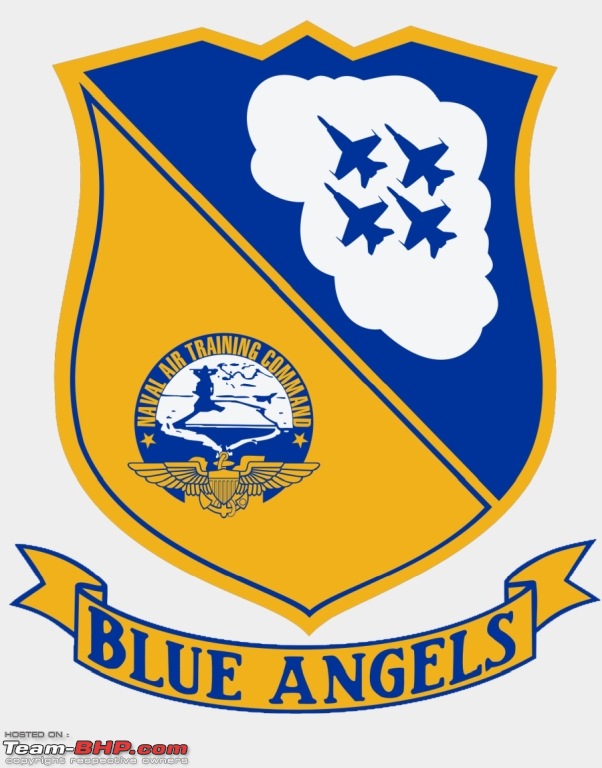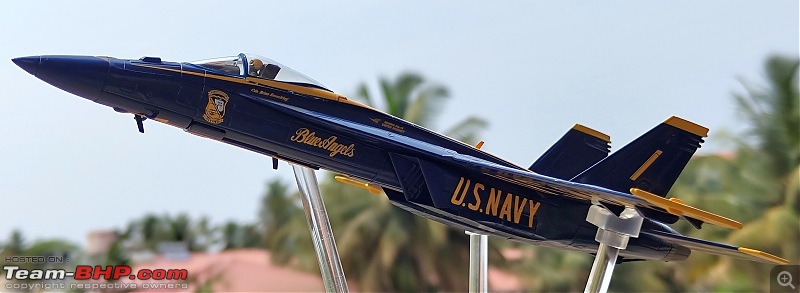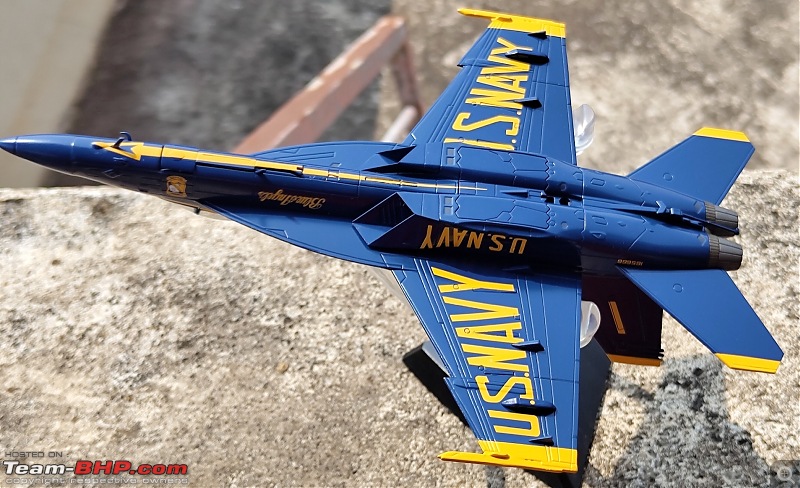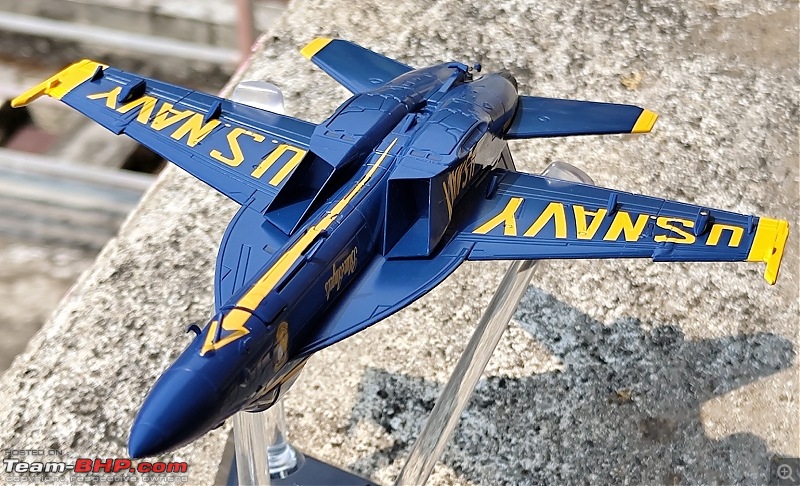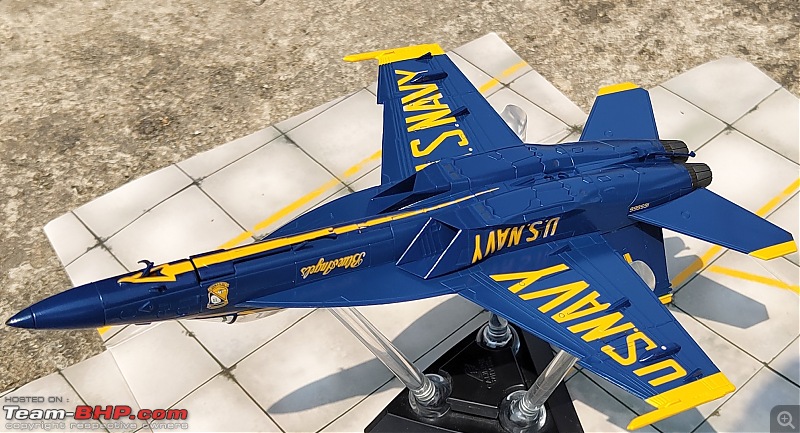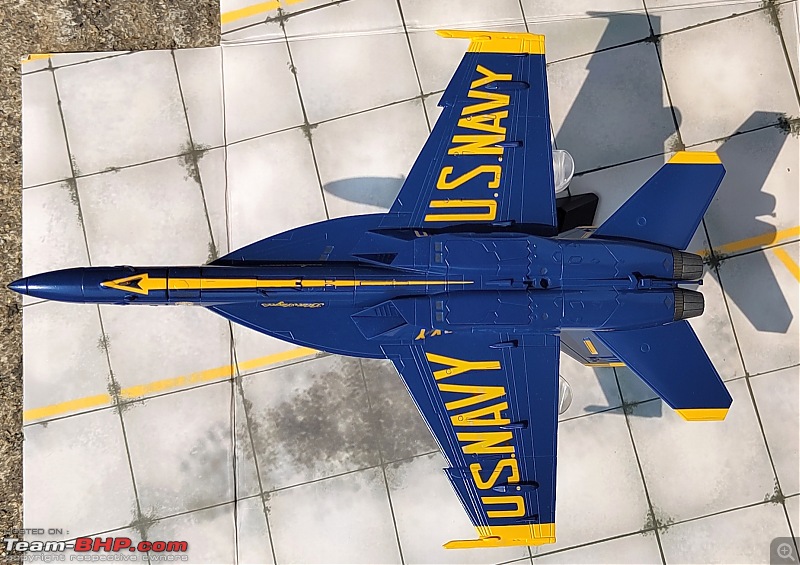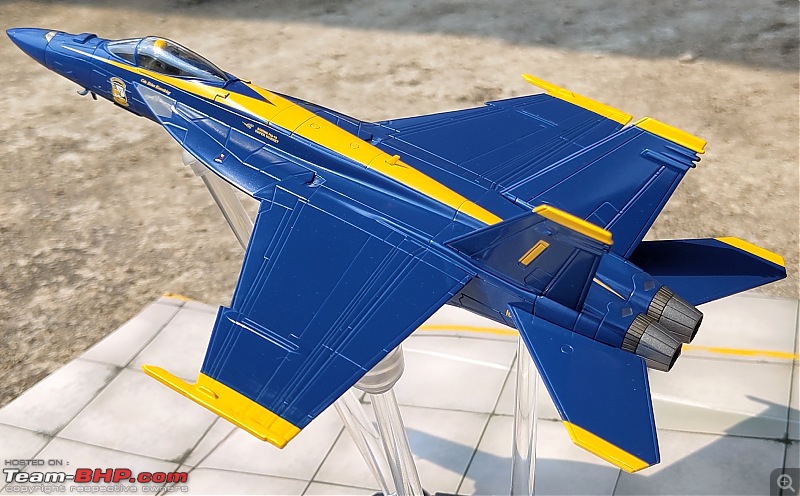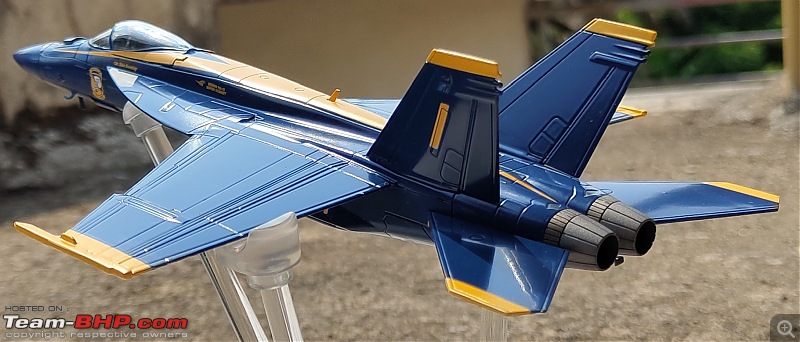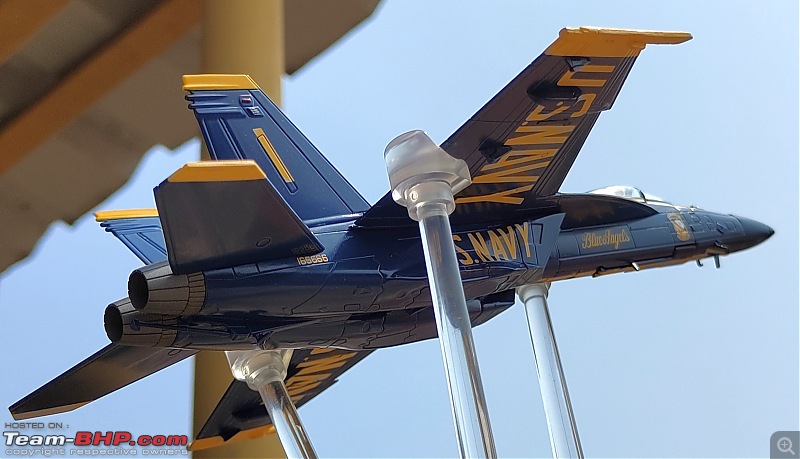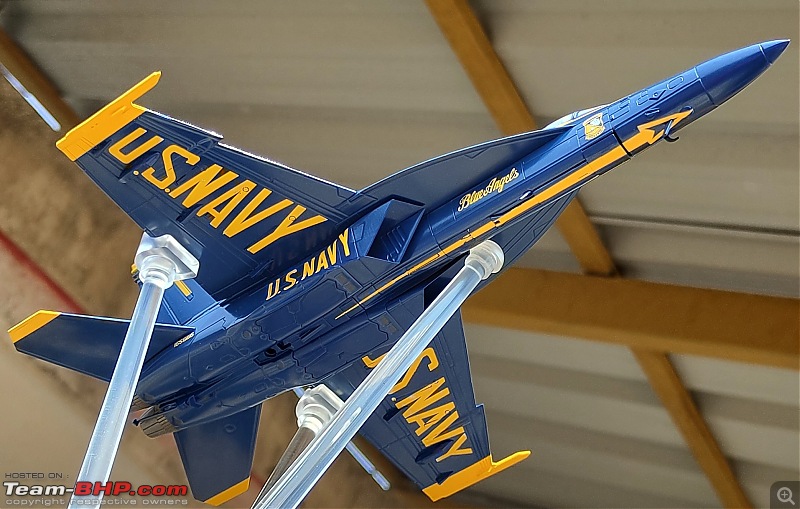| |||||||
| Search Forums |
| Advanced Search |
| Go to Page... |
 |
| Search this Thread |  692,143 views |
| | #2011 | |
| BHPian Join Date: May 2009 Location: NYC / Lucknow
Posts: 617
Thanked: 3,534 Times
| Re: Scale Models - Aircraft, Battle Tanks & Ships Quote:
I see the serial numbers are the same, if you have any spare decals from other models you can maybe modify the last digit to make them different planes. Last edited by Foxbat : 31st March 2023 at 00:56. | |
| |  (1)
Thanks (1)
Thanks
 |
| The following BHPian Thanks Foxbat for this useful post: | skanchan95 |
| |
| | #2012 | |
| Senior - BHPian | Re: Scale Models - Aircraft, Battle Tanks & Ships
Scalemodelcart. I had requested him for an additional Jaguar model, as I had damaged the original one I got from him years ago. When it became available with him again recently, I was more than happy to buy them to complete a formation flight display. Quote:
One of the things I like about these small 1/100 Italeri models is the attention given to the accuracy of markings - Just like the real thing, the aircraft serial number has been applied on the tail fins, underside of the wings and three digit numeral in Orange on the nose gear door.  Even if the decals were available, it till not be easy to remove the pad printed serial numbers without damaging the paint underneath. Besides, when viewed from a distance, they look fabulous on display.  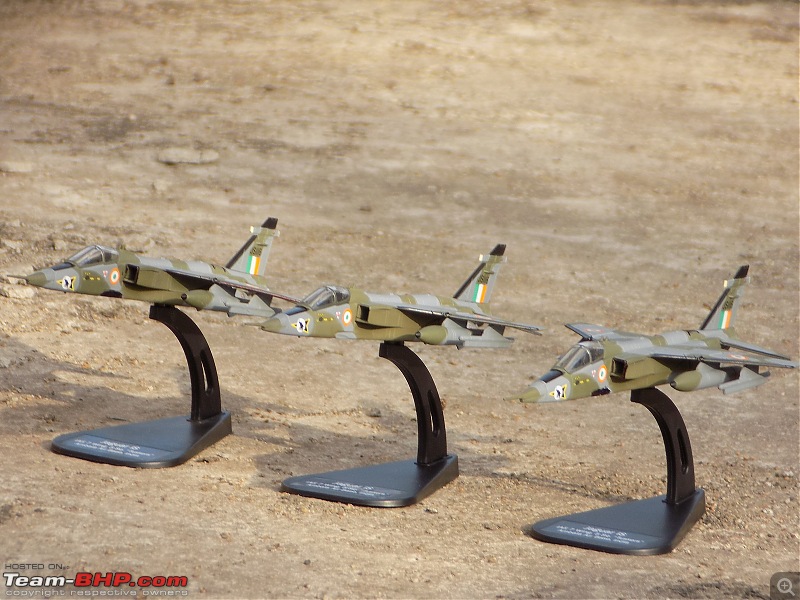  | |
| |  (4)
Thanks (4)
Thanks
 |
| The following 4 BHPians Thank skanchan95 for this useful post: | badboyscad, Foxbat, mh09ad5578, V.Narayan |
| | #2013 |
| Senior - BHPian | Re: Scale Models - Aircraft, Battle Tanks & Ships 1:200 Boeing KC-135R Stratotanker 62-3528, 911th Air Refueling Squadron, 916th Air Refueling Wing, United States Air Force, Seymour Johnson Air Force Base, North Carolina, 2020(Geminijets) The mainstay of the U.S. Air Force’s cold war/modern strategic aerial refueling fleet along with the KC-10 Extender, the KC-135 Stratotanker was a military version of the 1950s-era Boeing 707 commercial passenger jet and was a replacement of the KC-97 Stratotanker. Like its sibling, the commercial Boeing 707 jet airliner, the KC-135 was derived from the Boeing 367-80 jet transport "proof of concept" demonstrator, which was commonly called the "Dash-80". The KC-135 is similar in appearance to the 707, but has a narrower fuselage and is shorter than the 707. The KC-135 predates the 707, and being a military aircraft, is structurally quite different from the civilian airliner. Boeing had given the KC-135 tanker the initial designation as Model 717. The first flight of the KC-135A, named CITY OF RENTON, was on 31 August 1956, with first production delivery to Castle Air Force Base, California, in June 1957. The KC-135 was, of course, generously equipped with fuel tanks: * Three integral fuel tanks in each wing, with an inboard main tank having a capacity of 8,622 liters (2,275 US gallons), an outboard main tank with a capacity of 7,815 liters (2,062 US gallons), and a reserve tank further outboard with a capacity of 1,645 liters (434 US gallons). * A combination integral / bladder tank in the wing center section, with a capacity of 27,690 liters (7,306 US gallons). * A set of four bladder tanks in the lower deck forward of the wing, with a total capacity of 21,980 liters (5,800 US gallons); and five bladder tanks behind the wings, with a total capacity of 24,170 liters (6,378 US gallons). * A bladder tank in the aft upper deck, between the rear bulkhead and the refueling system operator's station in the tail, with a capacity of 8,240 liters (2,174 US gallons). If the upper deck tank wasn't installed, one of the four forward bladder tanks wasn't fitted either. Maximum fuel load on the KC-135A was 1,13,700 liters (30,000 US gallons). The fuel load limit was reduced if the KC-135A was carrying passengers or cargo. The KC-135A used single-point refueling. All the fuel could be used either to power the aircraft or offload to a receiver aircraft, except for the fuel in the reserve tanks. The tanker boom assembly was derived from that of the KC-97 and trialed on the Dash 80; later KC-135A production had a boom with improved streamlining, with earlier machines presumably updated to the revised boom configuration. Four turbofan engines, mounted under 35-degree swept wings, power the KC-135 to takeoffs at gross weights of up to 322,500 pounds. A cargo deck above the refueling system can hold a mixed load of passengers and cargo. Depending on fuel storage configuration, the KC-135 can carry up to 83,000 pounds of cargo. Nearly all internal fuel can be pumped through the flying boom at the back of the KC-135, the KC-135's primary fuel transfer method. The receiver aircraft would formant with the KC-135 and the 6'o clock position, flying slight below it. One crew member, known as the boom operator, stationed in the rear of the plane and controls the boom during in-flight air refueling. The boom operator lay prone in a rear compartment, observing a receiving aircraft through a set of windows, and "flying" the boom with a sidestrick controller, the boom being guided by vee wings onto the receiver aircraft's Universal air refuelling receptacle. There were dual rows of director lights on the lower fuselage to guide the pilot of a receiver aircraft; floodlights were eventually added to support the refueling system. An adapter kit was developed to permit the flying boom to be used with hose-drogue refueling(for receiver aircraft with a fixed/retractable refuelling probe). View from the boom operator's station  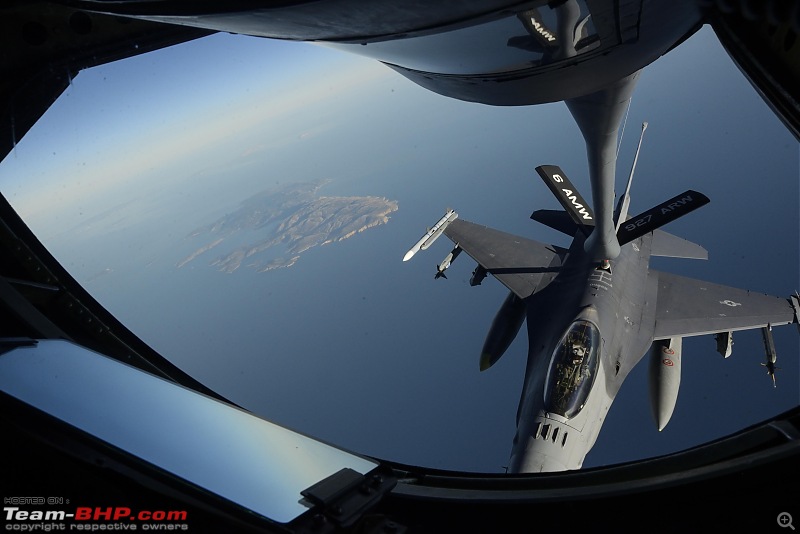 The "window" behind where the boom operator sits and observes receiving aircraft  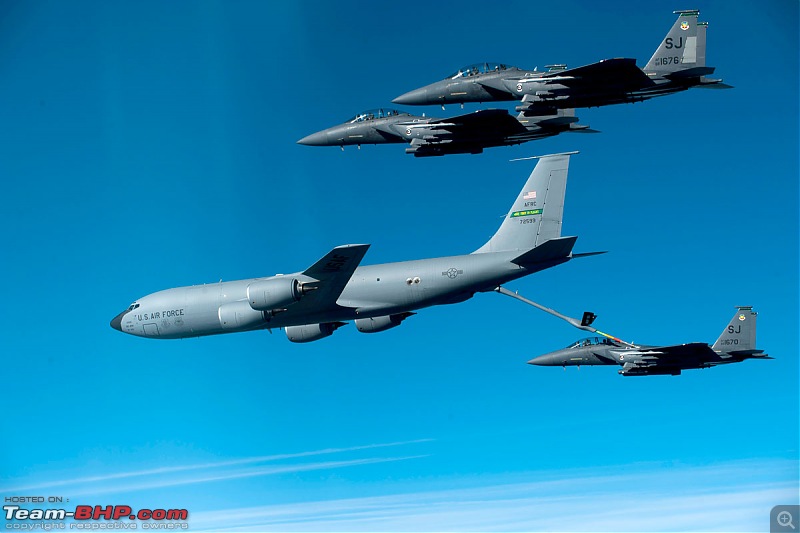 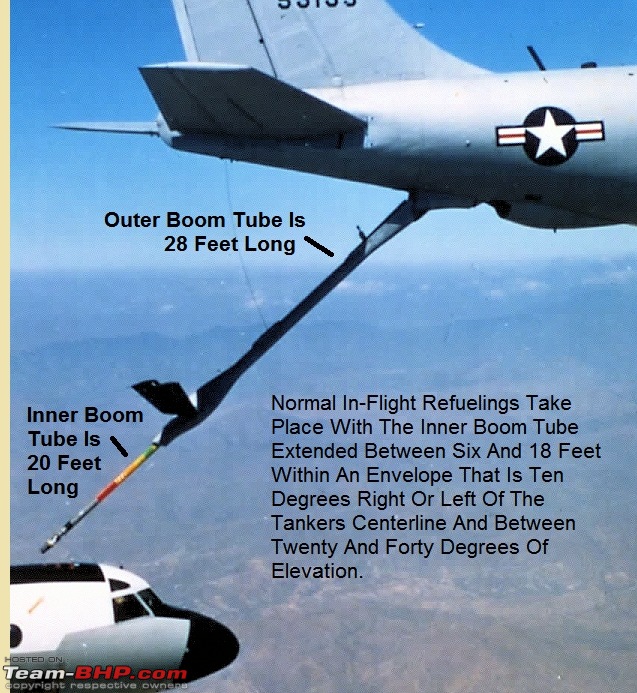 A special shuttlecock-shaped drogue attached to and trailing behind the flying boom may be used to refuel aircraft fitted with refuelling probes. Some aircraft have been configured with the multipoint refueling system, which consists of special pods mounted on the wingtips. These KC-135s are capable of refueling two receiver aircraft at the same time. Of the original KC-135As, more than 415 had been modified with new CFM-56 engines produced by CFM-International. The re-engined tanker, designated either the KC-135R or KC-135T, could offload 50 percent more fuel, was 25 percent more fuel efficient, costed 25 percent less to operate and was 96 percent quieter than the original KC-135As which were powered by Pratt & Whitney J57 engines. In the late 1970s, work began on a major upgrade of the USAF KC-135 fleet, the centerpiece being the CFM56-2B1 turbofan engine, military designation "F108-CF-100", with 97.9 kN (9,975 kgp / 22,000 lbf) thrust each. While the CFM56 became most closely identified with the Boeing 737 jetliner(-300 & later), the KC-135 was the first operational aircraft to be fitted with it. The increased power still meant a substantial increase in fuel load, well over 50%; the engines were also more fuel-efficient, quieter, and more reliable than the J57s, with an electronic engine monitoring system. The first "KC-135R" performed its initial flight in 1982, with conversions then ramping up. The KC-135Rs were given a range of updates along with the new engines, including: * Removal of the water-injection system plus fit of an engine fire-extinguisher system.(Water injection system - All original KC-135s were equipped with Pratt & Whitney J57-P-59W turbojet engines, which produced 10,000 lbf (44 kN) of thrust dry, and approximately 13,000 lbf (58 kN) of thrust wet. Wet thrust was achieved through the use of water injection on takeoff, as opposed to "wet thrust" when used to describe an afterburning engine. 670 US gallons (2,500 L) of water were injected into the engines over the course of three minutes. The water was injected into the inlet and the diffuser case in front of the combustion case. The water cooled the air in the engine to increase its density; it also reduced the turbine gas temperature, which was the primary limitation on many jet engines. This allowed the use of more fuel for proper combustion and created more thrust for short periods of time, similar in concept to "War Emergency Power" in a piston-engined aircraft). * Fit of twin APU turbines, for ground power and engine starting. There was an APU start button inside the cockpit crew door, allowing the crew to fire up the APU system while climbing aboard. * A wider tailplane, and a rudder yaw damper. * Reinforced landing gear, plus taxiing controls for both pilot and copilot using rudder pedals. * Collins WXR-700X color weather radar. * Partial glass cockpit with four LCD multifunction displays (MFD), and a fight management system. * Flight data recorder, cockpit voice recorder, and emergency locator transmitter. * GPS-based navigation system, meaning the navigator was no longer generally needed. * "Traffic Advisory & Collision Avoidance System (TCAS)" to prevent mid-air collisions, particularly during formation flight, and "Enhanced Ground Proximity Warning System (EGPWS)" to keep from flying into the ground. KC-135s have served/are serving in the Air Forces of United States, France, Turkey, Chile and Singapore. KC-135s are being gradually replaced with the modern KC-767(based on the Boeing 767) in USAF service and A330MRTT in French & Singaporean service. 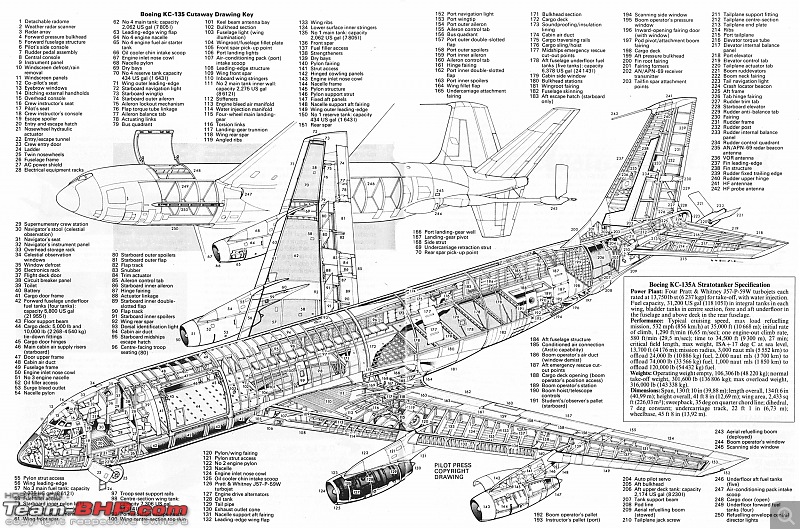 General characteristics Crew: 3 (pilot, co-pilot and boom operator; some KC-135 missions require the addition of a navigator.) Capacity: up to 80 passengers / 83,000 lb (38,000 kg) or 6 463L pallets Length: 136 ft 3 in (41.53 m) Wingspan: 130 ft 10 in (39.88 m) Height: 41 ft 8 in (12.70 m) Wing area: 2,433 sq ft (226.0 m2) Airfoil: root: BAC 310/311/312; tip: BAC 313[168] Empty weight: 98,392 lb (44,630 kg) Operating empty weight: 124,000 lb (56,245 kg) Gross weight: 297,000 lb (134,717 kg) Max takeoff weight: 322,500 lb (146,284 kg) Fuel capacity: 200,000 lb (90,718 kg) Powerplant: 4 × CFM International F108-CF-100 turbofan engines, 21,600 lbf (96.2 kN) thrust each Performance Maximum speed: 504 kn (580 mph, 933 km/h) Maximum speed: Mach 0.9 Cruise speed: 460.5 kn (529.9 mph, 852.8 km/h) at 30,000 ft (9,144 m) Range: 1,303.5 nmi (1,500.0 mi, 2,414.1 km) with 150,000 lb (68,039 kg) of transferable fuel Ferry range: 9,572 nmi (11,015 mi, 17,727 km) Service ceiling: 50,000 ft (15,000 m) Rate of climb: 4,900 ft/min (25 m/s) 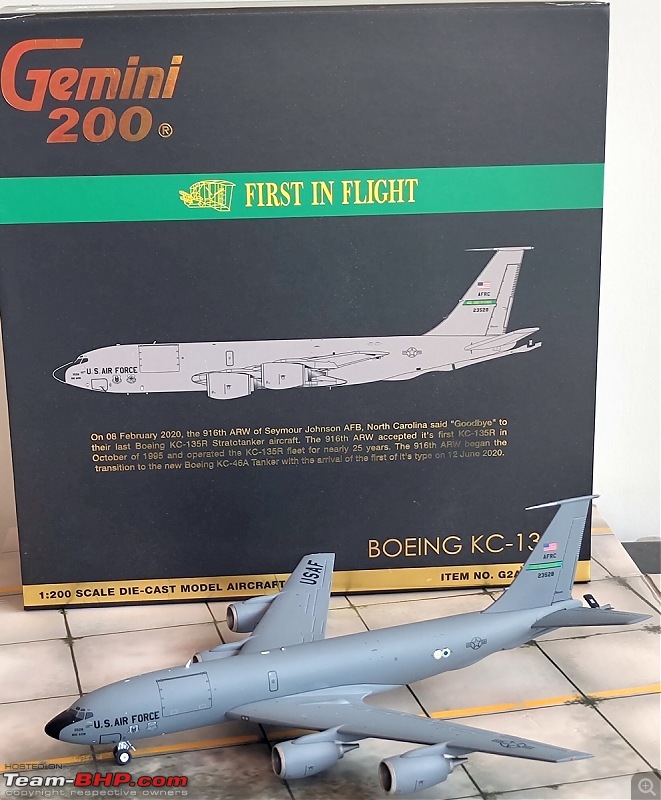 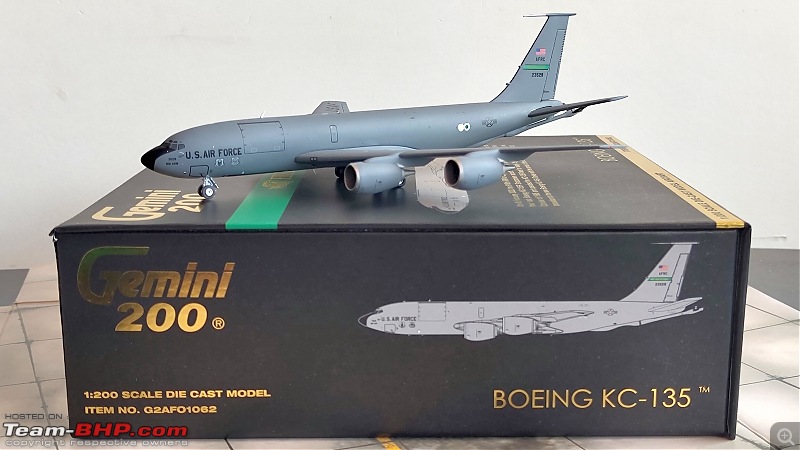 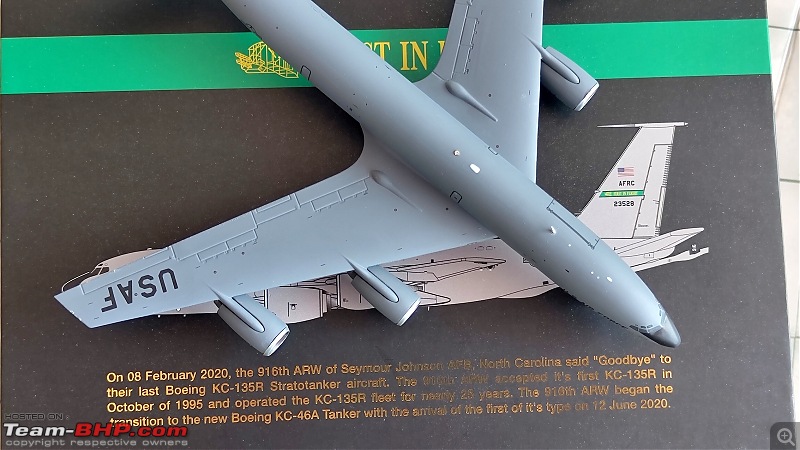 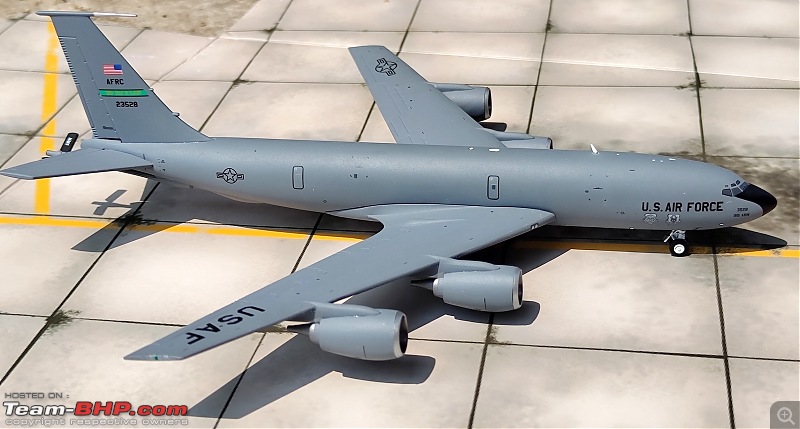 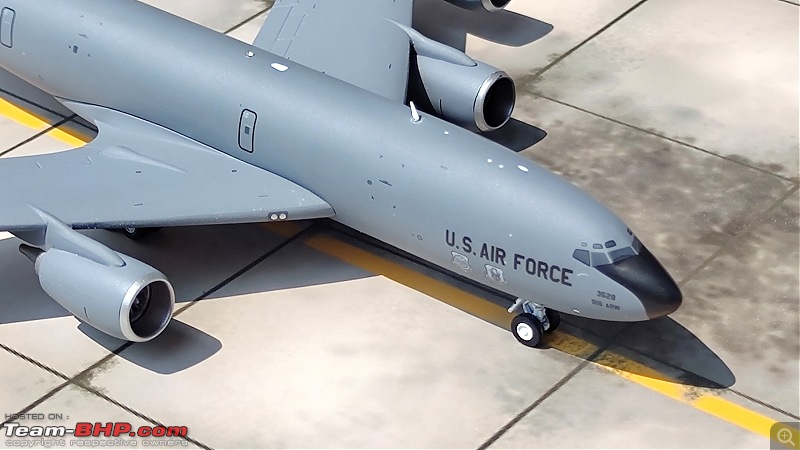   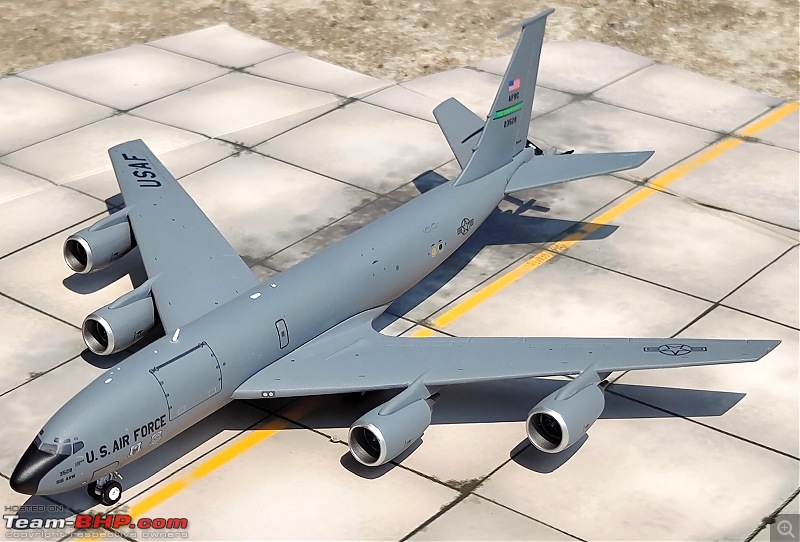 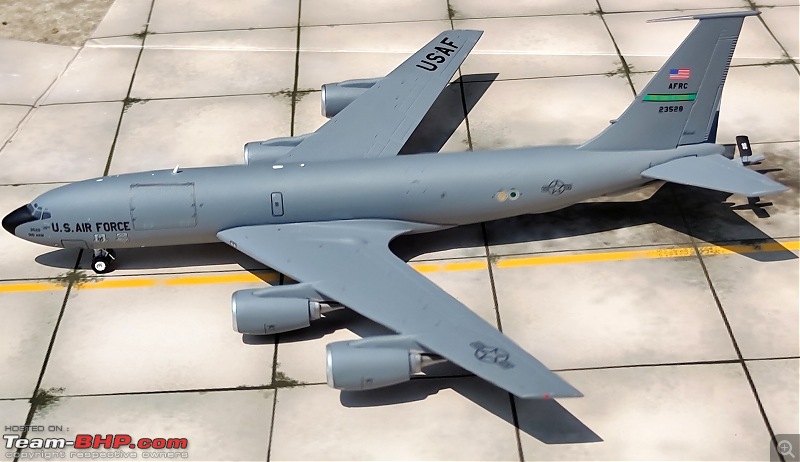 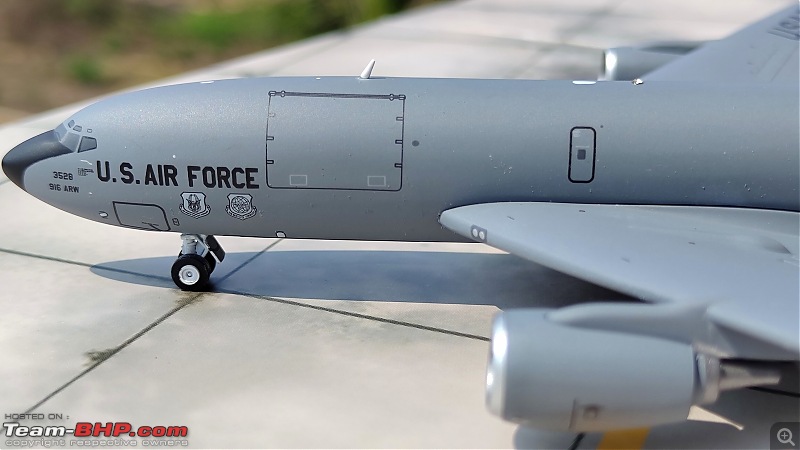 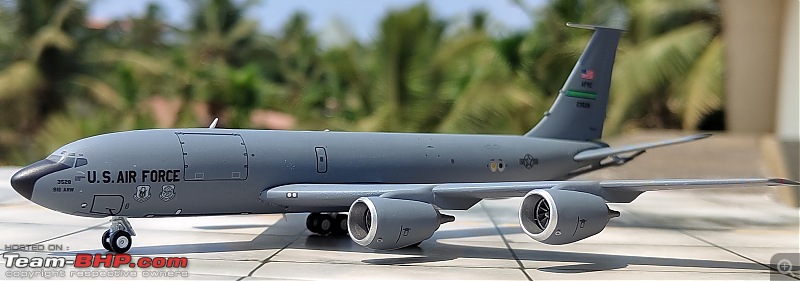 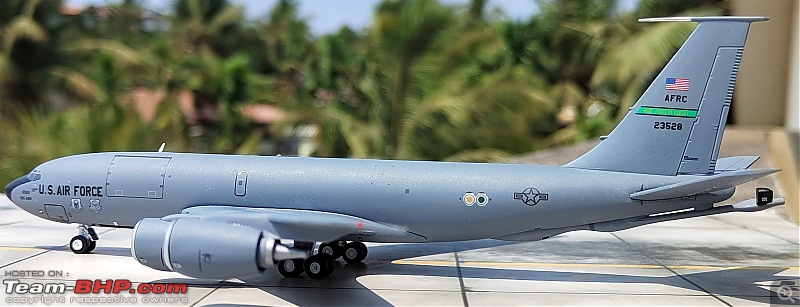 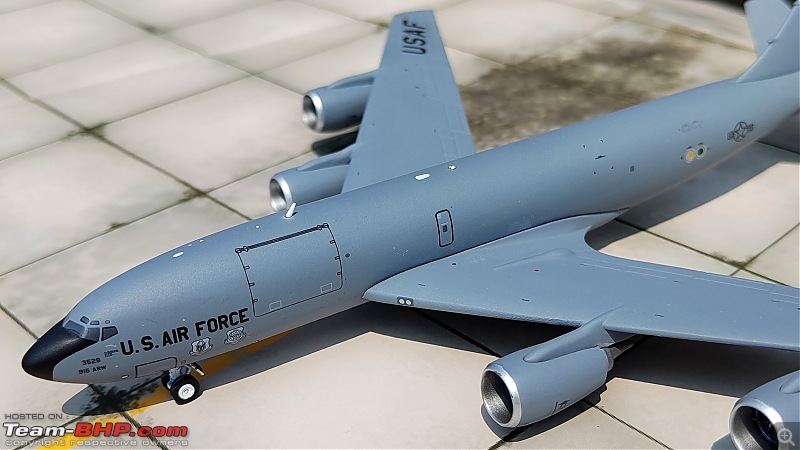 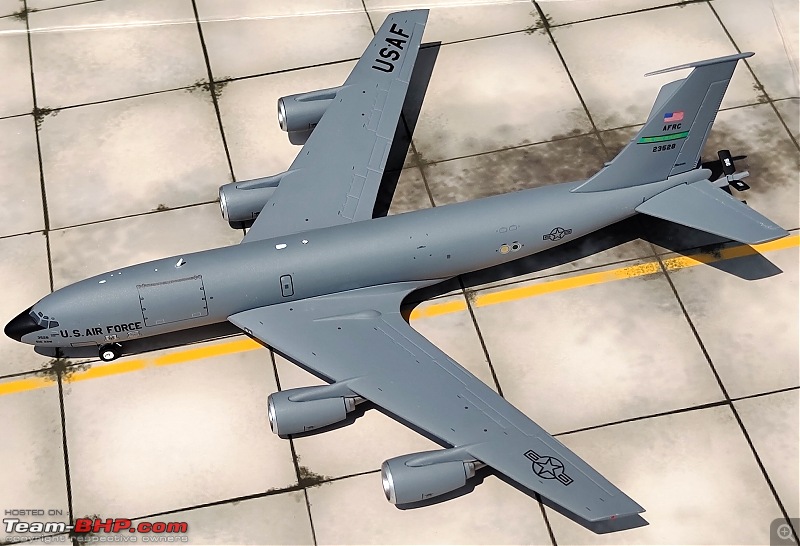 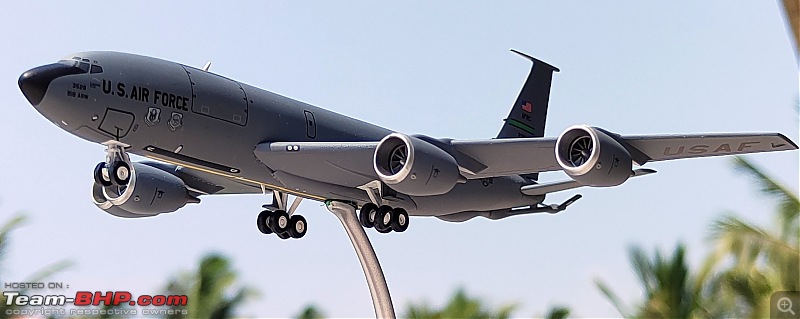 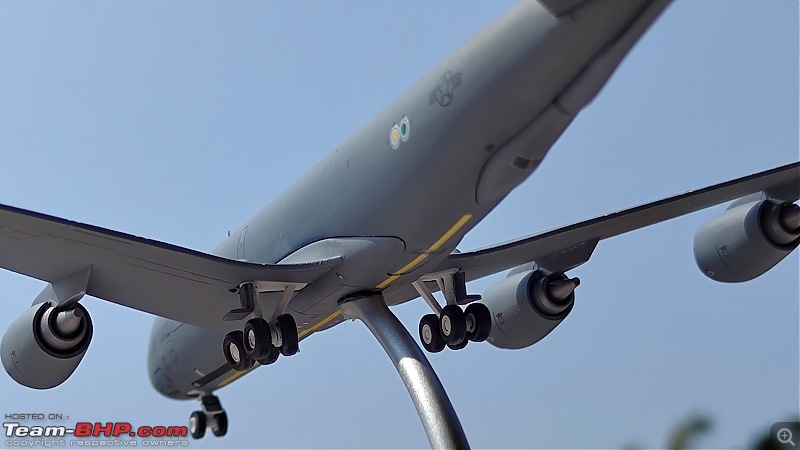  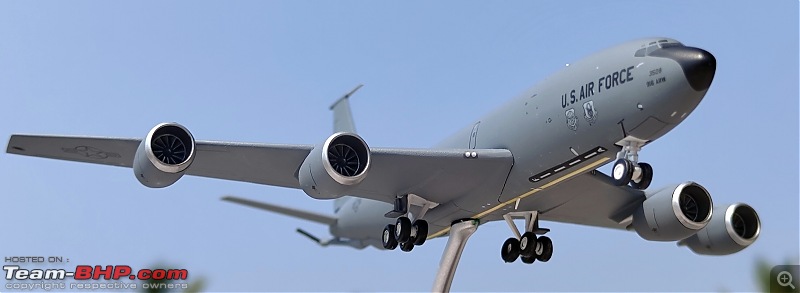 As mentioned above, the KC-135 is similar in appearance to the 707, but has a narrower fuselage and is shorter than the 707. 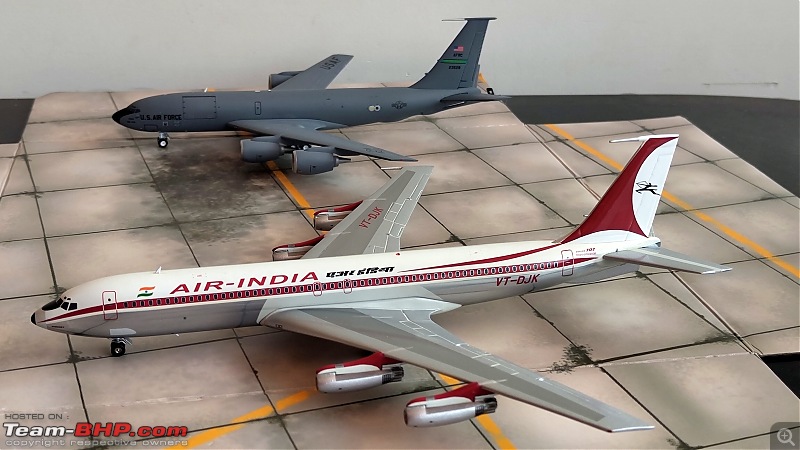   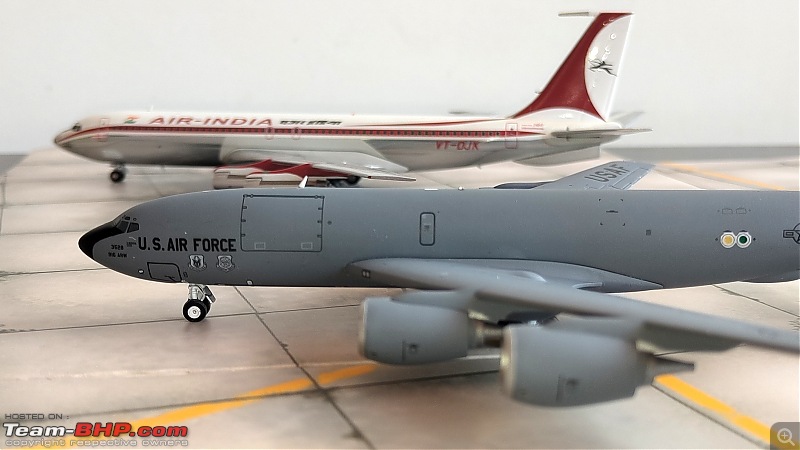  |
| |  (4)
Thanks (4)
Thanks
 |
| The following 4 BHPians Thank skanchan95 for this useful post: | badboyscad, Foxbat, Jeroen, V.Narayan |
| | #2014 | |
| Distinguished - BHPian  Join Date: Aug 2014 Location: Delhi-NCR
Posts: 4,071
Thanked: 64,307 Times
| Re: Scale Models - Aircraft, Battle Tanks & Ships Quote:
 Another unique addition to your fleet. Undoubtedly the father of all modern jet powered tankers. Till the Royal Air Force brought in the VC-10 conversions nothing of the same size and capability was available with any other Air Force. Thank you for the detailed write up as always which are a joy to read and refresh old knowledge long gone dusty. In the 1950s just the tanker fleet of the US Forces - KC-97 and KC-135 numbering~1600 was larger than the transport fleets of all Air Forces of the World put together when measured in military lift capacity in tonne-miles. The transport fleet was beyond this! It is unbelievable how much money they spent/still spend on arms procurement. | |
| |  (1)
Thanks (1)
Thanks
 |
| The following BHPian Thanks V.Narayan for this useful post: | skanchan95 |
| | #2015 | |
| BHPian Join Date: May 2009 Location: NYC / Lucknow
Posts: 617
Thanked: 3,534 Times
| Re: Scale Models - Aircraft, Battle Tanks & Ships Quote:
 Questions for the experts: is the P-51 Mustang associated with the Indian Air Force in any way? I think they were used by the Americans in India in WW2 but they didn't fly in Indian colours. I have this kit of a 1:48 P-51 which was gifted by a close relative which I have been told I can't gift to anyone else. I really don't have any interest in making it so was thinking of an unique project. 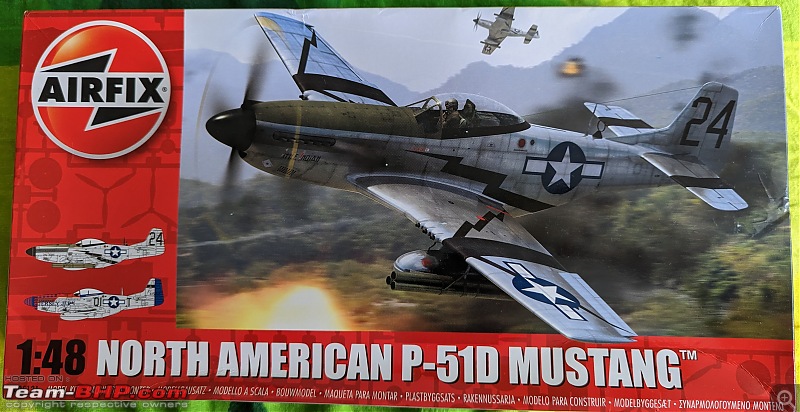 EDIT: just found out the Soviets flew the P-51 in World War 2, that would be an interesting project  Source: https://vvsairwar.com/2017/08/07/the...mk-i-fighters/ | |
| |  (2)
Thanks (2)
Thanks
 |
| The following 2 BHPians Thank Foxbat for this useful post: | skanchan95, V.Narayan |
| | #2016 | |
| Distinguished - BHPian  Join Date: Aug 2014 Location: Delhi-NCR
Posts: 4,071
Thanked: 64,307 Times
| Re: Scale Models - Aircraft, Battle Tanks & Ships Quote:
It is often seen that pilots of one nation or flying culture do not take to aircraft and cockpits of another. So MiG-29 pilots looked down on the F-16 and Amercian pilots look down on all Soviet fast jets! Cultural acclimatization I guess. In WW-II Soviet aircraft were almost always far more rugged, had very strong landing gears, engines designed for being flown all the time at maximum revs and designed for rough field forward strips operations in dust, snow and extreme cold. Western aircraft other than the centre engine mounted American Airacobra P-39 were deemed too fragile. The Spitfire was laughed at. Only the Hawker Hurricane just about held its own but is engine could not be flown at full throttle throughout the mission - so almost always got left behind on a mission with the Yaks!! You get the drift. Thought I'd toss in these titbits, Foxbat, and make your day.  Painting it in Soviet colours would not be incorrect historically. Last edited by V.Narayan : 30th April 2023 at 06:47. | |
| |  (2)
Thanks (2)
Thanks
 |
| The following 2 BHPians Thank V.Narayan for this useful post: | Foxbat, skanchan95 |
| | #2017 | |
| BHPian Join Date: May 2009 Location: NYC / Lucknow
Posts: 617
Thanked: 3,534 Times
| Re: Scale Models - Aircraft, Battle Tanks & Ships Quote:
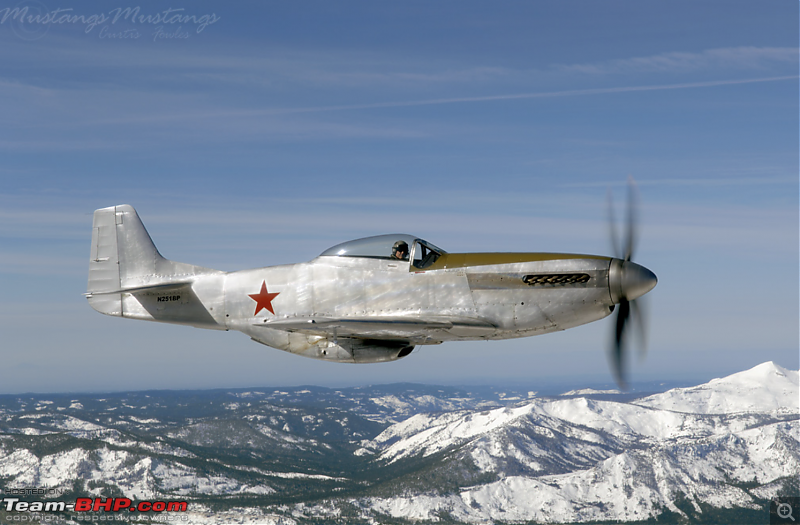 | |
| |  (2)
Thanks (2)
Thanks
 |
| The following 2 BHPians Thank Foxbat for this useful post: | skanchan95, V.Narayan |
| | #2018 | |
| Distinguished - BHPian  Join Date: Aug 2014 Location: Delhi-NCR
Posts: 4,071
Thanked: 64,307 Times
| Re: Scale Models - Aircraft, Battle Tanks & Ships Quote:
| |
| |  (2)
Thanks (2)
Thanks
 |
| The following 2 BHPians Thank V.Narayan for this useful post: | Foxbat, skanchan95 |
| | #2019 |
| Distinguished - BHPian  | Re: Scale Models - Aircraft, Battle Tanks & Ships Fox bay, you would probably know, but I learned the other day the USSR also flew the American P39 during world war 2. Apparently quite a lot of them, well over 4000 planes, almost half the number of Cobra s produced went to the Soviets. Jeroen |
| |  (2)
Thanks (2)
Thanks
 |
| The following 2 BHPians Thank Jeroen for this useful post: | Foxbat, skanchan95 |
| | #2020 |
| Senior - BHPian | Re: Scale Models - Aircraft, Battle Tanks & Ships 1:200 Boeing C-17A Globemaster III 05-5140, 729th Airlift Squadron, 452nd Air Mobility Wing, United States Air Force, March Air Reserve Base, California, 2019(Geminijets) In the 1980s, following experiments with demonstrators for short-field transport aircraft in the 1970s, the US Air Force began development of a new large military transport, which would emerge as the McDonnell-Douglas, later Boeing, "C-17" in the 1990s. The USAF would go on to acquire a large fleet of C-17s, with a number of export users obtaining it as well, including India(which is the second largest operator of the type in the world). Nicknamed "The Moose", the C-17 was derived from the YC-15 - a smaller prototype airlifter designed during the 1970s, but was scaled up and had many changes.Compared to the YC-15, the redesigned airlifter differed in having swept wings, increased size, and more powerful engines. On 15 September 1991, roughly one year behind schedule, the first C-17 performed its maiden flight. The C-17 formally entered USAF service on 17 January 1995. Boeing, which merged with McDonnell Douglas in 1997, continued to manufacture the C-17 for almost two decades. The final C-17 was completed at the Long Beach, California plant and flown on 29 November 2015. The C-17 is powered by four Pratt & Whitney F117-P-100 high-bypass turbofans with 185.5 kN (18,915 kg / 41,700 lb) thrust each, similar to the commercial P&W P2040 turbofans used on the Boeing 757 jetliner. The engines have thrust reversers to reduce landing roll and for ground handling, with the aircraft able to back up a shallow slope. The thrust reversers deflected the thrust upwards, and so the engines could remain powered up while the aircraft was being quickly unloaded -- allowing it to take off again immediately once unloading was complete. There are two distinctive little fins on each upper engine cowling, acting as "vortex generators" to ensure airflow over the wing and delay onset of stall at high angles of attack. A Honeywell auxiliary power unit (APU) turbine was fitted in the front of the right main landing gear sponson to provide engine starting and ground power; a "ram air turbine" would be extended from the right sponson in the case of a comprehensive power failure, to provide hydraulic system power for minimal flight control. There are six fuel tanks in the wings, with a total capacity of 102,614 liters (27,108 US gallons), and an inflight refueling socket behind the cockpit. An inert-gas generation system helped reduce fuel system fires or explosions. In later production, at least some C-17s were fitted with a wing center-section tank with a capacity of 36,340 liters (9,600 US gallons) of fuel, these aircraft being informally designated as "C-17 ER". It is unclear if all C-17s were eventually kitted up to ER specification. The nose landing gear have two wheels, while each of the two main gear assemblies had six wheels in two rows of three. The nose gear retracted forward and was steerable by rudder pedals, as well as a tiller for tight ground maneuvering. The main gear extended straight down from its sponsons; all landing gear assemblies would open by gravity in case of system failure. The robust landing gear could support steep-angle combat zone landings. Normal crew consists of two pilots and a loadmaster, with seats for two more cockpit crew as cockpit observers. The C-17 had a "glass cockpit" with four displays, plus a "head-up display (HUD)" for each pilot. The aircraft features a quadruplex fly-by-wire flight control system; the pilots used sticks and not yokes. Avionics included radios, radio navigation and landing systems, identification friend or foe (IFF) transponder, and a weather radar in the nose. One particularly interesting item of avionics kit was a "Formation Flight System" that allows C-17s to perform mass airdrops in zero visibility with no great hazard of collision. The C-17 is equipped with an onboard oxygen generator system (OBOGS) to eliminate the need for stocking oxygen bottles. There is also a fire extinguishing system, but though it can be assumed it protects the engines, details are unclear. The C-17 has defensive countermeasures, featuring threat-warning receivers and chaff-flare dispensers. There is a rest area behind the cockpit on the upper deck, with two bunks and two seats; the upper deck also featured a galley and a lavatory. The loadmaster had a workstation under the rest area in the lower deck. There is an "airstair" door for the crew on the left front of the aircraft into the lower deck, with a matching emergency exit door on the right, and a hatch on top of the cockpit upper deck for emergency escape. There are roll-up doors on each side of the rear fuselage for parajumping, with a deployable screen ahead of each door. There are two hatches on top forward of the wing box, and two similar hatches behind the parajump doors, for emergency escape. The tail door assembly had two sections, the top section hinging up into the payload bay, the lower ramp section hinging down. The cargo bay has a length of 20.78 meters (68 feet 2 inches), a height under the wing center section is 3.76 meters (12 feet 4 inches), and a maximum useful width of 5.49 meters (18 feet). There was a load-handling system, including rollers, running the full length of the cargo bay. There were 17 tip-up seats along each side of the cargo bay, and 48 more seats could be installed in the center of the cargo bay, providing seats for 102 fully-equipped troops; pallets providing 100 seats could be installed as an alternative, giving 154 seats. Another option was installation of 48 stretchers in place of the center seats. The fuselage was as wide as that of a C-5 Galaxy, and cargo loads could include: * An M1 main battle tank with two support vehicles. * Two Bradley fighting vehicles with two support vehicles. * Four Sikorsky UH-60 Black Hawk helicopters. * Two Boeing AH-64 Apache helicopter gunships and three Bell OH-58 Kiowa scout helicopters. * Up to 11 standard pallets. Absolute maximum payload was 78,100 kilograms (172,200 pounds), but a typical payload was 56,250 kilograms (124,000 pounds), with a heavy operational payload running to 69,535 kilograms (153,300 pounds). The C-17 could carry 18 times the payload of the classic C-47 / DC-3 -- which, considering the modest size of the C-47, was not so impressive -- but the C-17 could take off from and land on shorter runways, which was very impressive. The C-17 had excellent short-field capability and proved surprisingly agile for an aircraft of its size, performance being well superior to its predecessor cargolifters in USAF service. It established a number of records in its class and would prove a muscular ride when unladen, compared at least in some respects to flying a fighter jet. The USAF ended up acquiring a fleet of 223 C-17s, not counting the prototype and including an attrition replacement -- for an aircraft lost with its crew of four during a training flight in Alaska in 2010. The last USAF Moose was delivered in 2013. There were a fair number of export orders for the C-17 too and the userwise numbers are detailed below United States Air Force- 224 (including prototype but not the 2 static-test airframes) Indian Air Force- 11 Royal Air Force- 8 Royal Australian Air Force- 8 United Arab Emirates Air Force- 8 Qatar Air Force- 8 Royal Canadian Air Force- 5 NATO - 3 Kuwait Air Force- 2 ____________ Total 277 Boeing operates support for the C-17 on a "global" basis, which means in practice that any one operator can obtain spares, and to a degree assistance, from any other C-17 operator. General characteristics Crew: 3 (2 pilots, 1 loadmaster) Capacity: 170,900 lb (77,519 kg) of cargo distributed at max over 18 463L master pallets or a mix of palletized cargo and vehicles 102 paratroopers or 134 troops with palletized and sidewall seats or 54 troops with sidewall seats (allows 13 cargo pallets) only or 36 litter and 54 ambulatory patients and medical attendants or Cargo, such as one M1 Abrams tank, two Bradley armored vehicles, or three Stryker armored vehicles Length: 174 ft (53 m) Wingspan: 169 ft 9.6 in (51.755 m) Height: 55 ft 1 in (16.79 m) Wing area: 3,800 sq ft (350 m2) Aspect ratio: 7.165 Airfoil: root: DLBA 142; tip: DLBA 147[218] Empty weight: 282,500 lb (128,140 kg) Max takeoff weight: 585,000 lb (265,352 kg) Fuel capacity: 35,546 US gal (29,598 imp gal; 134,560 l) Powerplant: 4 × Pratt & Whitney F117-PW-100 turbofan engines, 40,440 lbf (179.9 kN) thrust each Performance Cruise speed: 450 kn (520 mph, 830 km/h) (Mach 0.74–0.79) Range: 2,420 nmi (2,780 mi, 4,480 km) with 157,000 lb (71,214 kg) payload Ferry range: 6,230 nmi (7,170 mi, 11,540 km) Service ceiling: 45,000 ft (14,000 m) Wing loading: 150 lb/sq ft (730 kg/m2) Thrust/weight: 0.277 (minimum) Takeoff run at MTOW: 8,200 ft (2,499 m) Takeoff run at 395,000 lb (179,169 kg): 3,000 ft (914 m) Landing distance: 3,500 ft (1,067 m) with maximum payload Avionics AlliedSignal AN/APS-133(V) weather and mapping radar 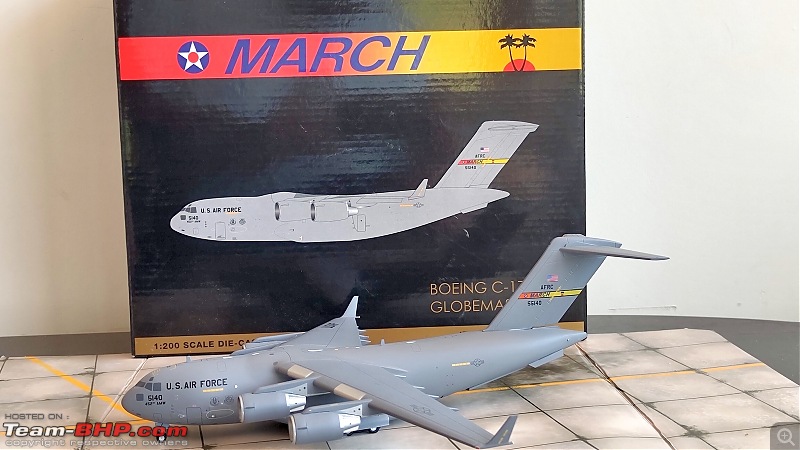 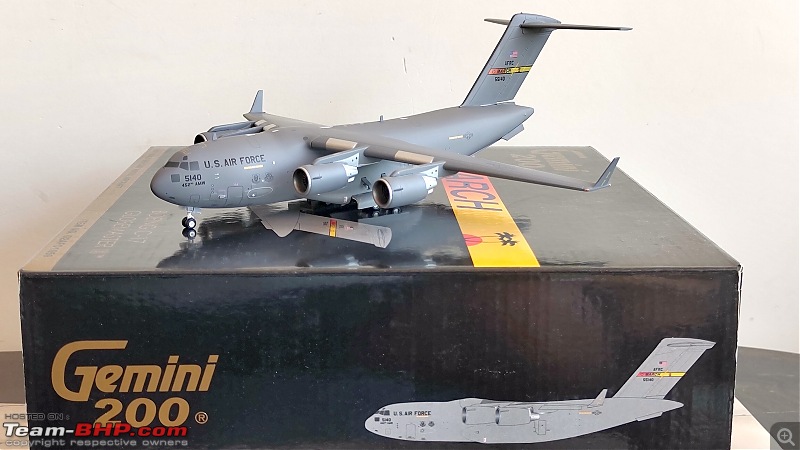  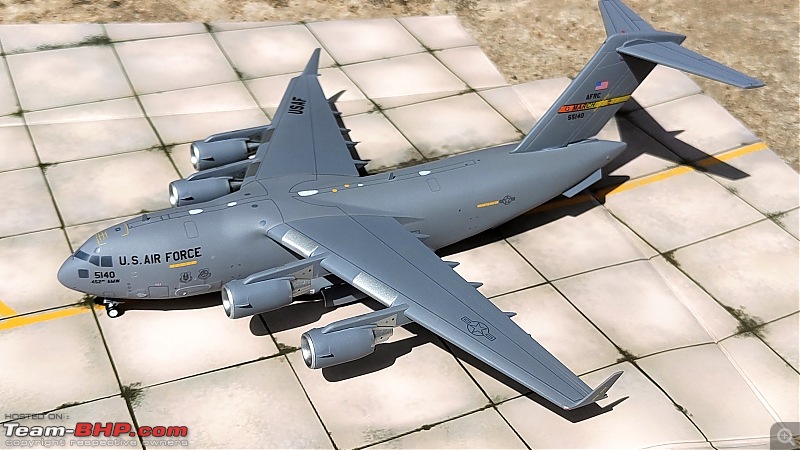 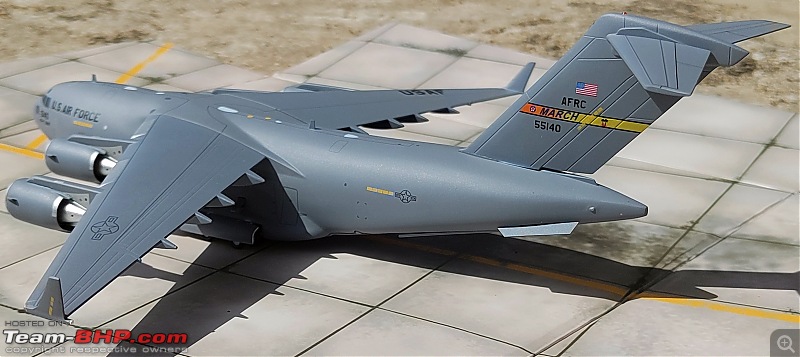  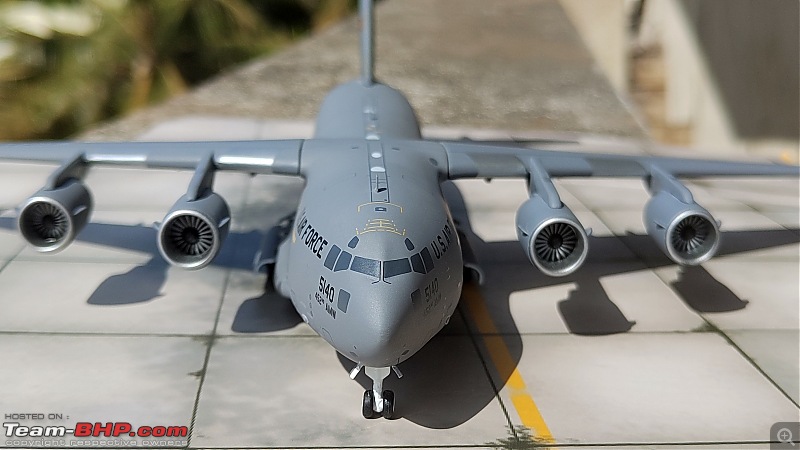  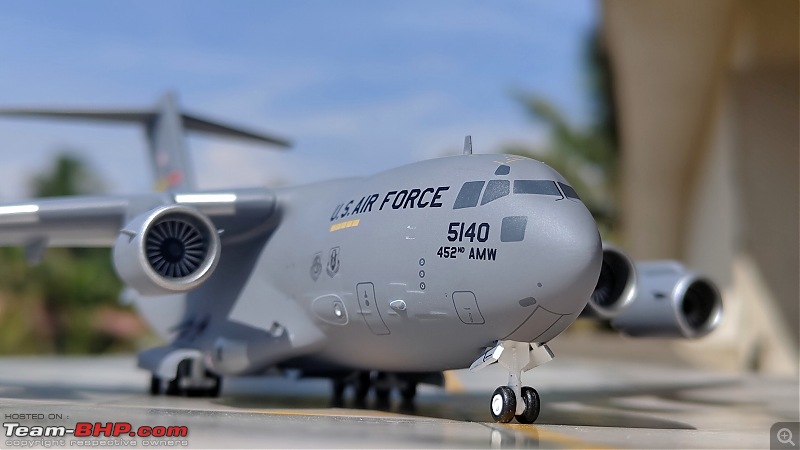 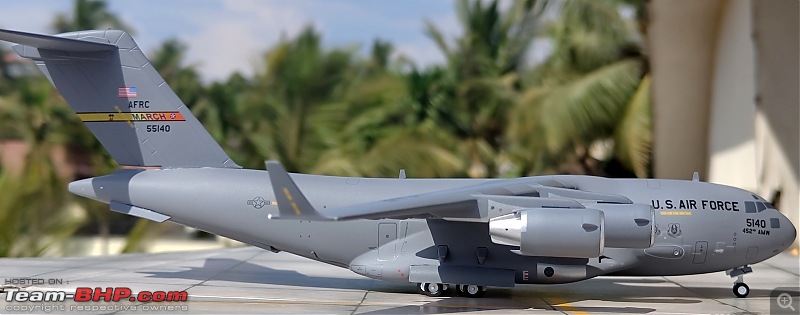 The 452nd AMW was awarded the Air and Space Outstanding Unit Award in the year 2017 and this C-17 has the Ribbon painted above the main entrance door. 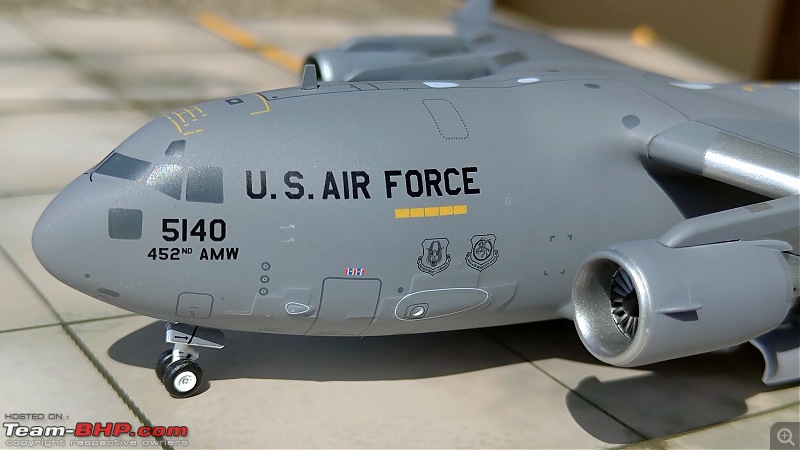  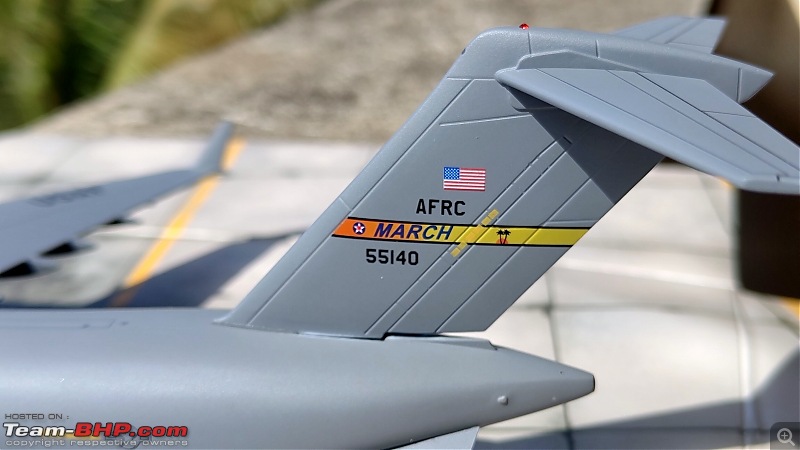  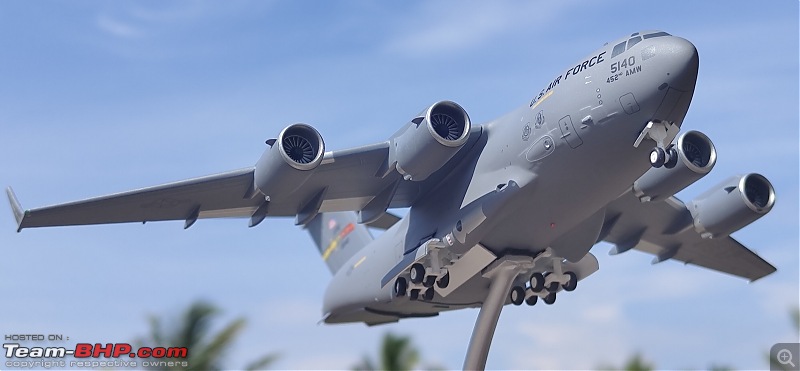  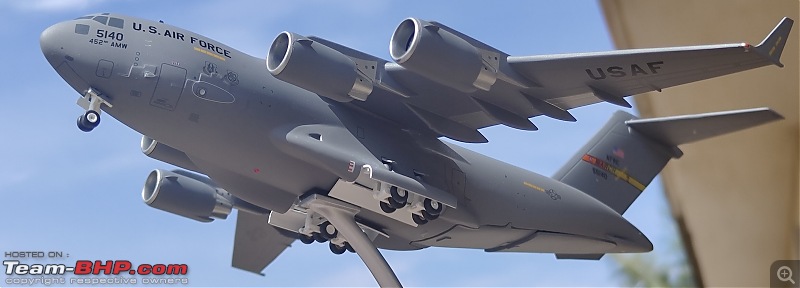 My 1:200 C-17s: 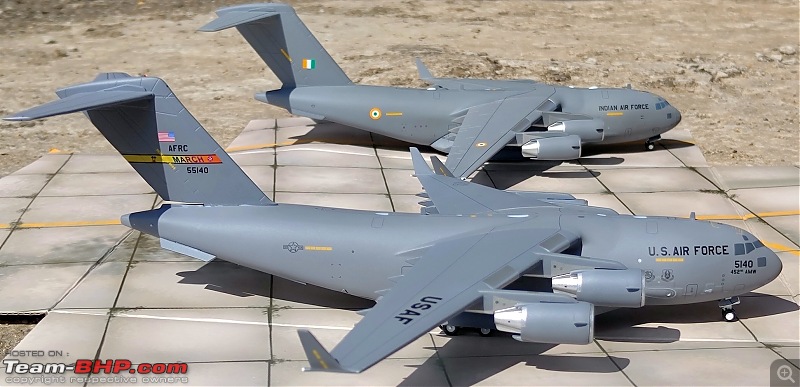 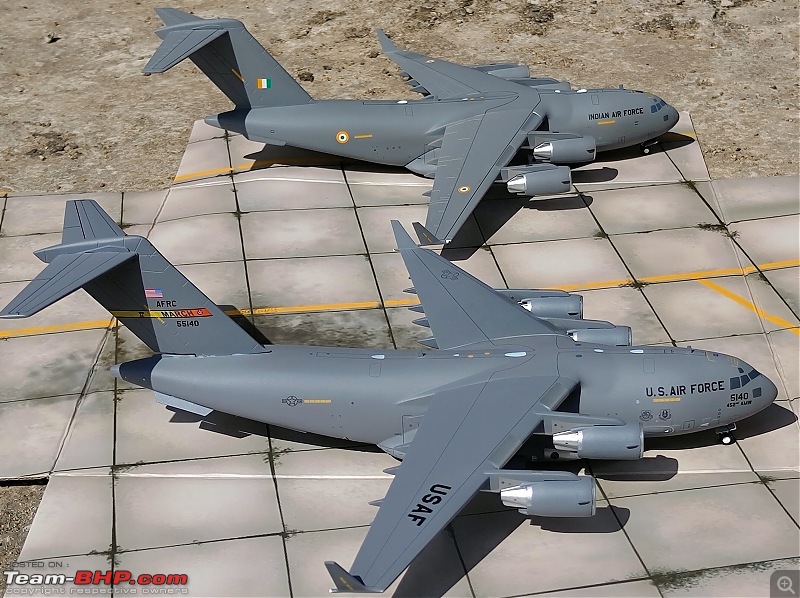 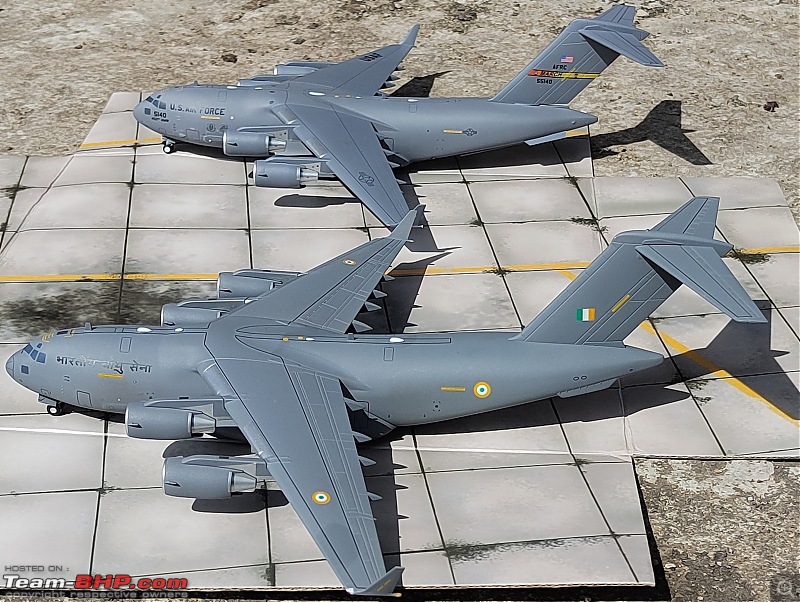 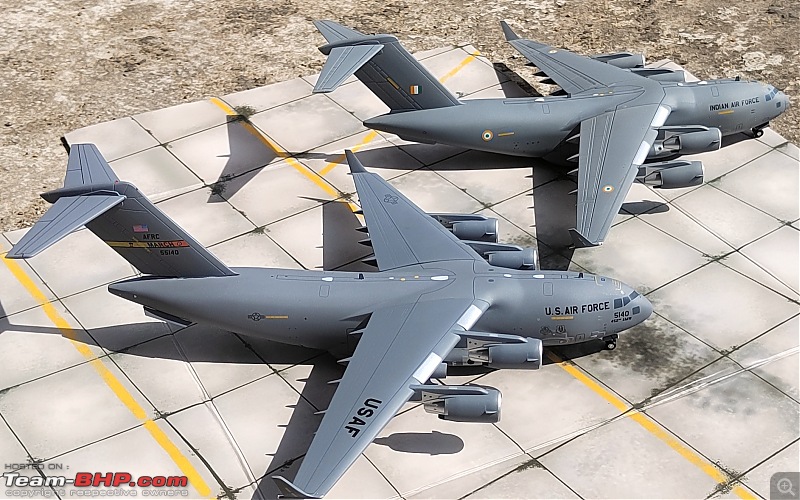 USAF Airlifters  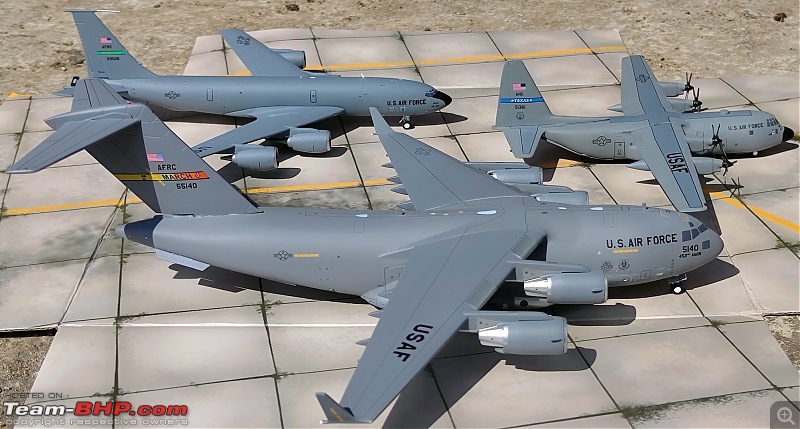 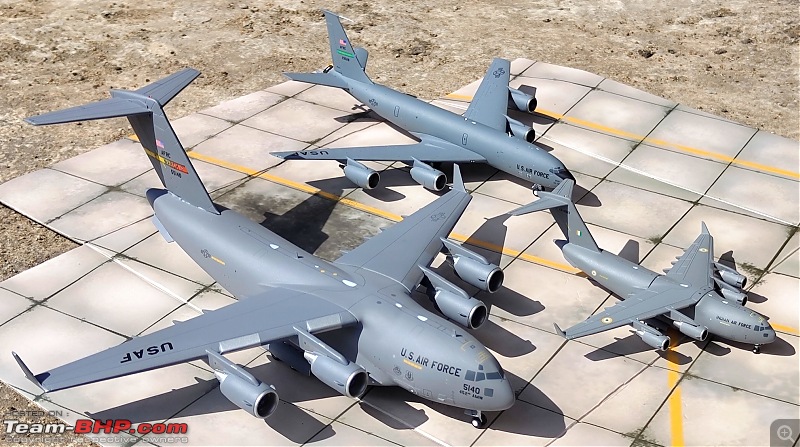 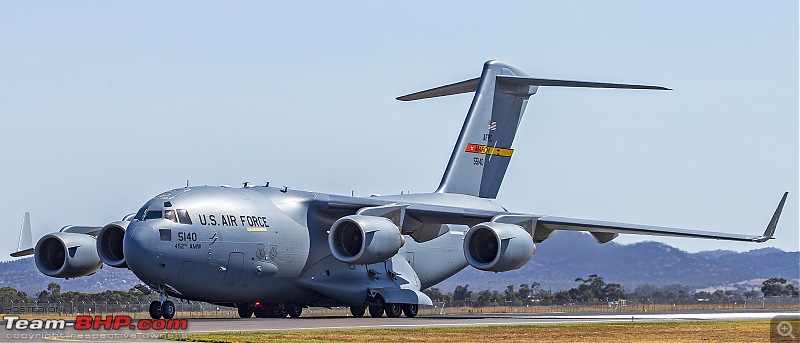 |
| |  (4)
Thanks (4)
Thanks
 |
| The following 4 BHPians Thank skanchan95 for this useful post: | badboyscad, Foxbat, Jeroen, V.Narayan |
| | #2021 | |
| Senior - BHPian | Re: Scale Models - Aircraft, Battle Tanks & Ships 1:72 Boeing F/A-18E Super Hornet Blue Angels, Blue 1 Bu No. 165666, 2021 (75th Anniversary) (Hobbymaster) Currently flying the Boeing F/A-18E/F Super Hornet, the US Navy and Marine Corps joint Aerobatic team - The Blue Angels, are the world's second oldest aerobatic team (after France's Patrouille de France). The team usually comprises of six US Navy and one US Marine Corps demonstration pilots pulled out from operational US Navy & USMC fighter squadrons. The Blue Angels were formed in 1946 on the Grumman F6F-5 Hellcat. They later transitioned to the Grumman F8F-1 Bearcat before beginning transition to the jet age on the Grumman F9F Panther and later the supersonic Grumman F-11F-1 Tiger. By the end of the 1960s, the Blue Angels were flying the McDonnell Douglas F-4J Phantom. In 1974, they transitioned to the Douglas A-4 Skyhawk, a smaller and lighter aircraft with a tighter turning radius allowing for a more dynamic flight demonstration. In 1986, they celebrated their 40th Anniversary by unveiling the Boeing McDonnell Douglas F/A-18A/B Hornet as their new ride. In 2021, they transitioned to their current aircraft the Boeing F/A-18E/F Super Hornet. The Blue Angels aircraft are painted in Navy Blue with golden Yellow letterings. The aircraft strength is 9 (Demonstrations use 6 X F/A-18E Super Hornets (single seat- #1 to 6); The backup is a pair of F/A-18F #7; and a C-130J "Fat Albert" for their logistics, carrying spare parts, equipment, and to carry support personnel between shows.) Blue Angels Demonstration aircraft over the years Grumman F6F-5 Hellcat: June – August 1946 Grumman F8F-1 Bearcat: August 1946 – 1949 Grumman F9F-2 Panther: 1949 – June 1950 (first jet); F9F-5 Panther: 1951 – Winter 1954/55 Grumman F9F-8 Cougar: Winter 1954/55 – mid-season 1957 (swept-wing) Grumman F11F-1 (F-11) Tiger: mid-season 1957 – 1968 (first supersonic jet) McDonnell Douglas F-4J Phantom II: 1969 – December 1974 Douglas A-4F Skyhawk: December 1974 – November 1986 McDonnell Douglas F/A-18A Hornet (F/A-18B as #7): November 1986 – 2010 Boeing F/A-18A+/C (B/D as #7) Hornet: 2010-2020 Boeing F/A-18E Super Hornet (F/A-18F as #7): 2020–Present The Blue Angels also had a support aircraft to ferry crew and equipment to airshows right from their inception. With their C-130, nicknamed Fat Albert, they used to perform a Short take off and climb at a high Angle of Attack using eight Jet-Assisted Take-Off (JATO) rocket bottles, producing 1,000 pounds of thrust each. They helped propel Fat Albert on short runways and gain good amount of altitude in a short period of time. 2009 was the last show season for the use of JATO rocket bottles as the manufacturer stopped producing them. Blue Angels Support aircraft JRB Expeditor (Beech 18): 1949–? Douglas R4D-6 Skytrain: 1949–1955 Curtiss R5C Commando: 1953 Douglas R5D Skymaster: 1956–1968 Lockheed C-121 Super Constellation: 1969–1973 Lockheed C-130 Hercules "Fat Albert": 1970–2019 (JATO usage was stopped in 2009) Lockheed Martin C-130J Super Hercules "Fat Albert"(ex-RAF): 2020–present The team flew the legacy Hornet for 34 years from 1986 through 2020. The team currently flies the larger and more powerful Boeing F/A-18 Super Hornet. In August 2018, Boeing was awarded a contract to convert nine single-seat F/A-18E Super Hornets and two F/A-18F two-seaters for Blue Angels use. Modifications to each F/A-18E/F include removal of the weapons and replacement with a tank that contains smoke-oil used in demonstrations and outfitting the control stick with a spring system for more precise aircraft control input. Each modified F/A-18 remains in the fleet and can be returned to combat duty aboard an aircraft carrier within 72 hours. The show's narrator flies Blue Angels No. 7, a two-seat F/A-18F Hornet, to show sites. The Blues use these jets for backups, and to give demonstration rides to VIP (civilians). Usually, two back seats rides are available at each air show; one goes to a member of the press, and the other to the "Key Influencer". The No. 4 slot pilot often flies the No. 7 aircraft in Friday's "practice" so that pilots from the fleet and future team members can experience the show. Aerobatic Formation Flying While Aerobatic formation flying is thrilling to look at and the pilots make it look easy, it is a very dangerous and demanding job. There have been many accidents during such aerobatic demonstration flights. The most terrible of which was in the late 1980s, when there was a mid air collision between MB.339s of the Frecce Tricolori - the Italian Air Force's aerobatic team. Three MB339s during their display, smashed into each other during a head-on pass, with the wreckages crashing to the ground in front of a crowd of about 300,000 people. There were 70 fatalities (67 spectators and three pilots) and 346 spectators sustained serious injuries in the resulting explosion and fire, and hundreds more had minor injuries All navigation, radio transmissions, and tactical decisions are made by the flight leader, who is typically the most experienced pilot. The other pilots in a formation are known as wingmen, and it is their responsibility to follow the leader and to maintain a constant position relative to the lead aircraft. This is called “position keeping.” Any change in relative position between aircraft is considered movement by the wingmen. In the case of a single wingman, his goal is to keep his distance from the leader constant by choosing two features on the lead aircraft and keeping them aligned in the same way from his viewpoint. Any change in the alignment of these two features indicates that his relative position to the leader has changed. In larger formations the other wingmen either hold position on the plane in front or alongside of them or look through that airplane at the lead aircraft and hold position on the leader. While flying in formation, pilots constantly try to match the lead aircraft’s speed by making many small but often rapid throttle/power changes. As one becomes more experienced these changes become fewer in between and smaller in amplitude, but the need for intense concentration and focus does not. Because flying close to another airplane can be extremely dangerous, discipline, practice, predictability, and strict rule-following are encouraged in both civilian and military environments. Flights are briefed so that all pilots know what to expect and so that, generally, no one except the leader needs to speak on the radio. Leaders use hand signals, head nods, aircraft movements, or radio calls to alert their wingmen of changes in flight attitude, formation positions, split-ups, rejoins, and radio frequencies. Commander Brian Kesselring  Commander Brian C. Kesselring(later Captain) was the Blue Angels Commanding Officer from 2019 to 2022. Being the CO, he always flew the Blue Angels Hornet with Tail No. 1. Prior to joining the Blue Angels in September 2019, Cdr Kesselring served as commanding officer of VFA-81 “Sunliners” flying the F/A-18E. Under his command, the Blue Angels transitioned from the F/A-18C/B to the larger F/A-18E/F in November 2020. Capt Kesselring handed over the command of the Blue Angels to Cdr Alex Armatas in November 2022. Quote:
1. Cdr Brian Kesselring, USN - Flight Leader & CO 2. Lt Cdr James Haley, USN 3. Maj Frank Zastoupil, USMC 4. Lt Cdr James Cox, USN 5. Lt Cdr Brandon Hempler, USN 6. Lt Cdr Cary Rickoff, USN 7. Lt Julius Bratton, USN 8. Lt. Cdr Adam Kerrick, USN 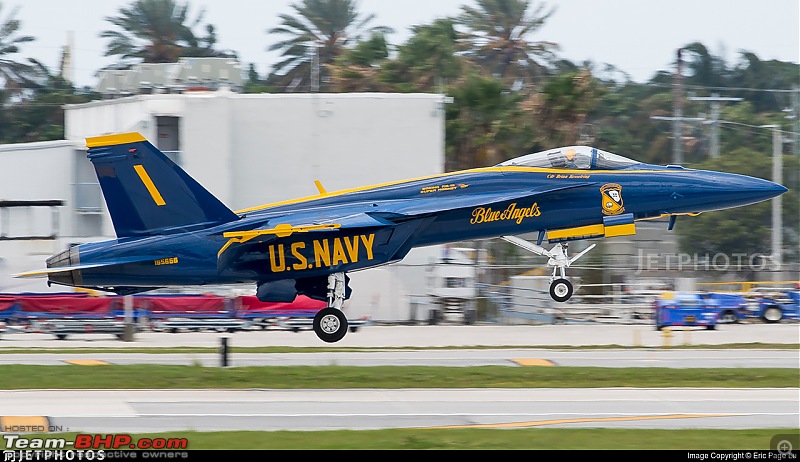 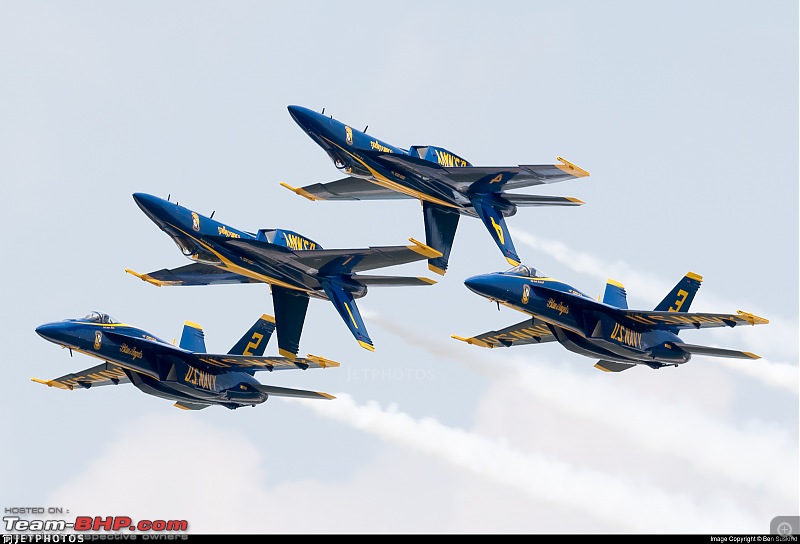  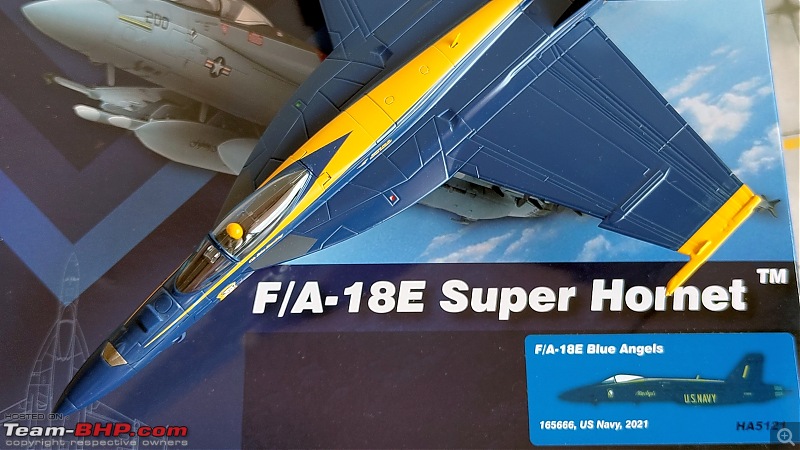 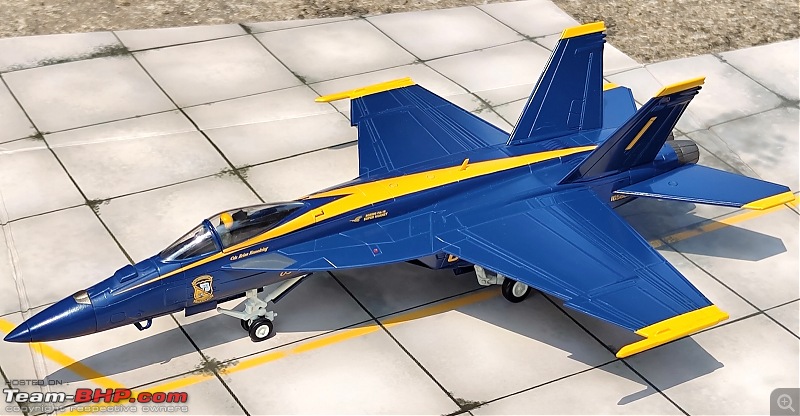 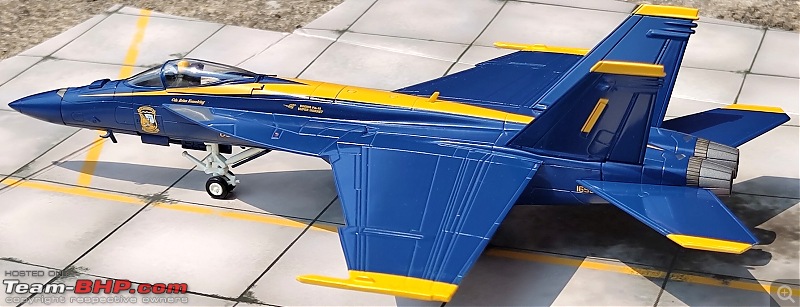  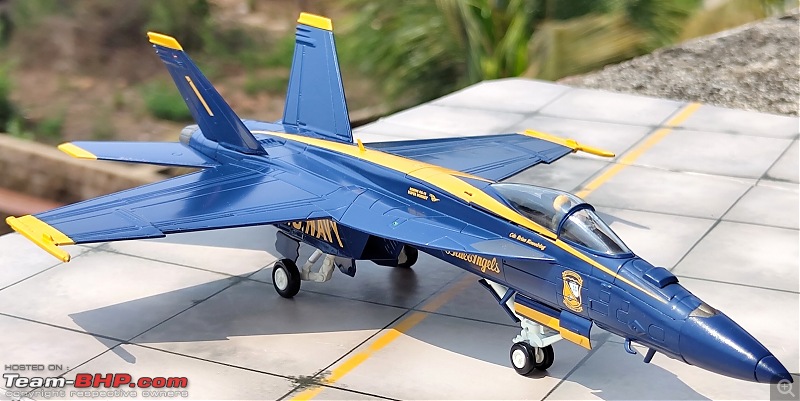 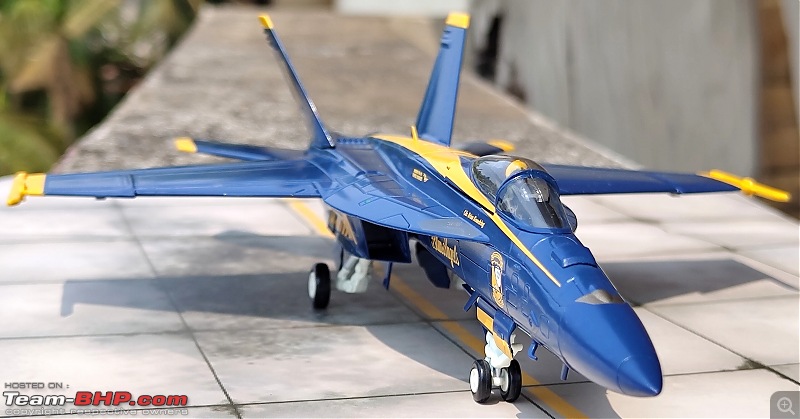 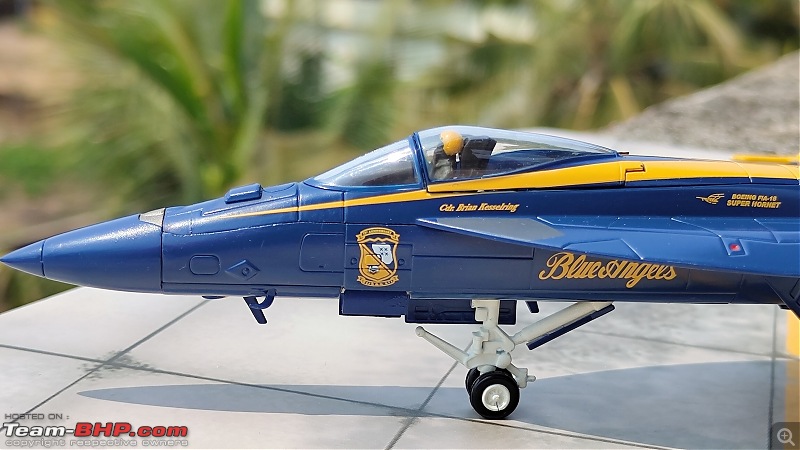 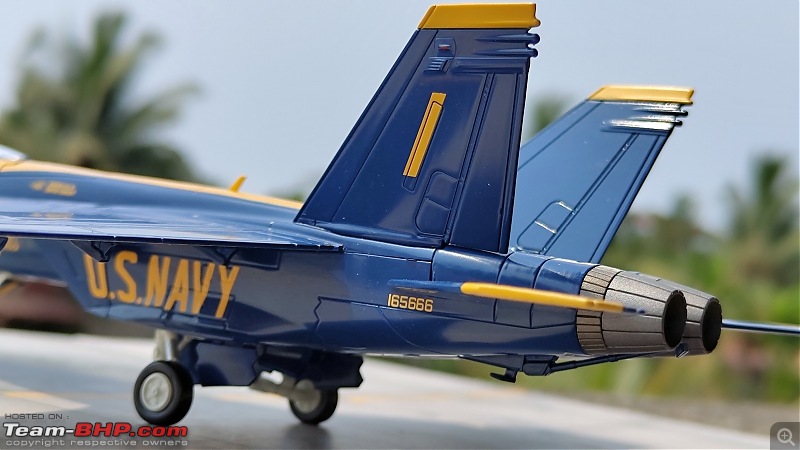 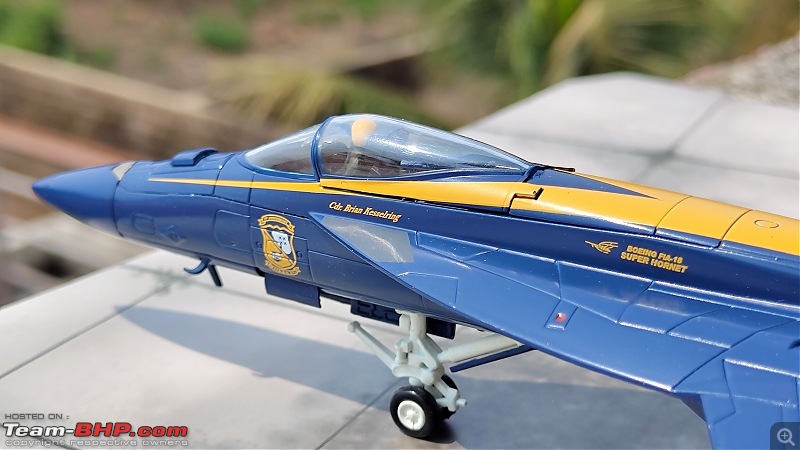 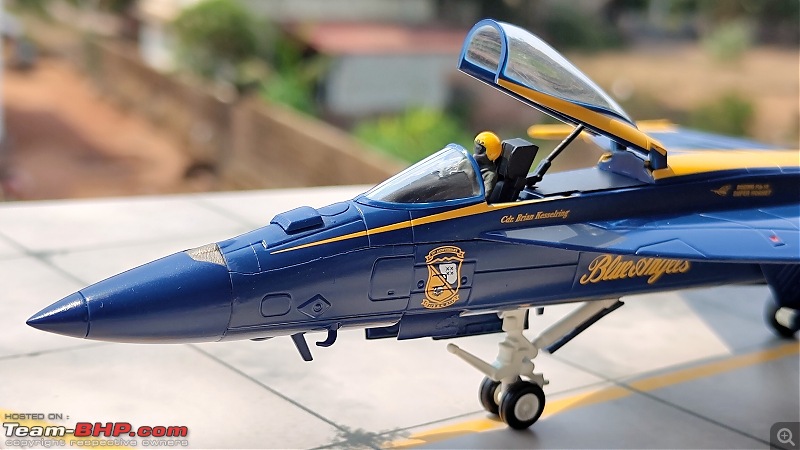  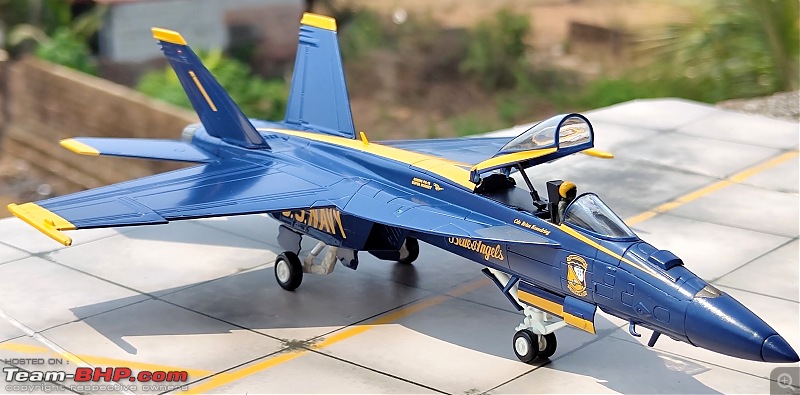  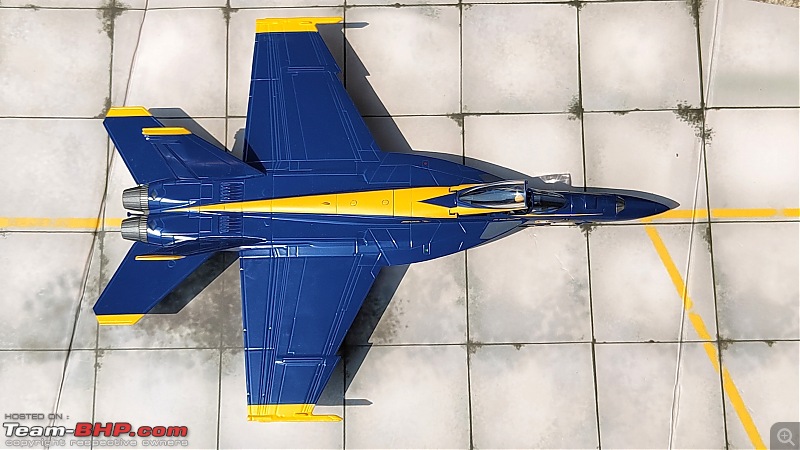 Cdr Brian Kesselring's old squadron- VFA-81 Sunliners (JC Wings) 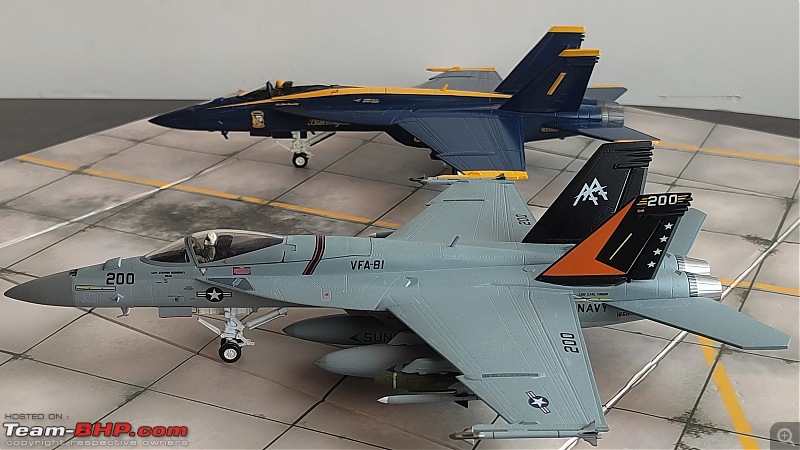 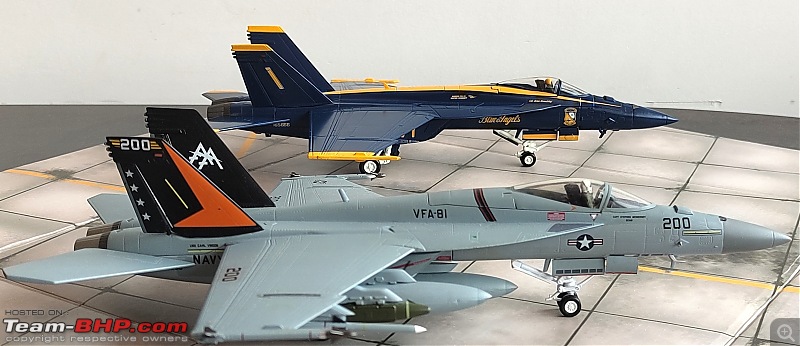 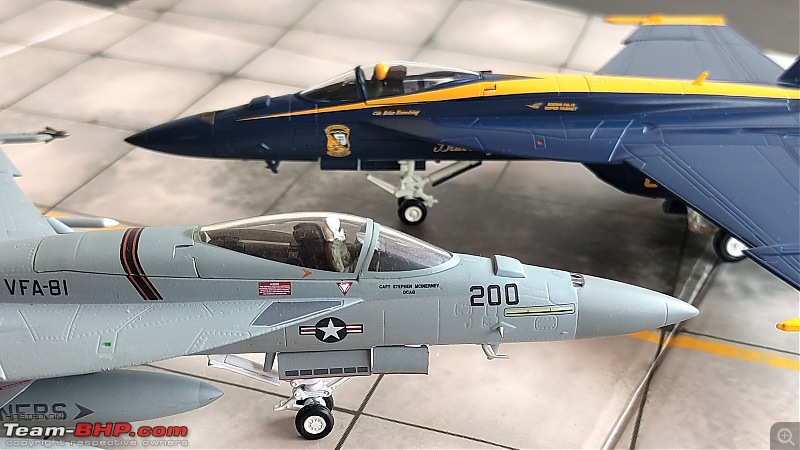 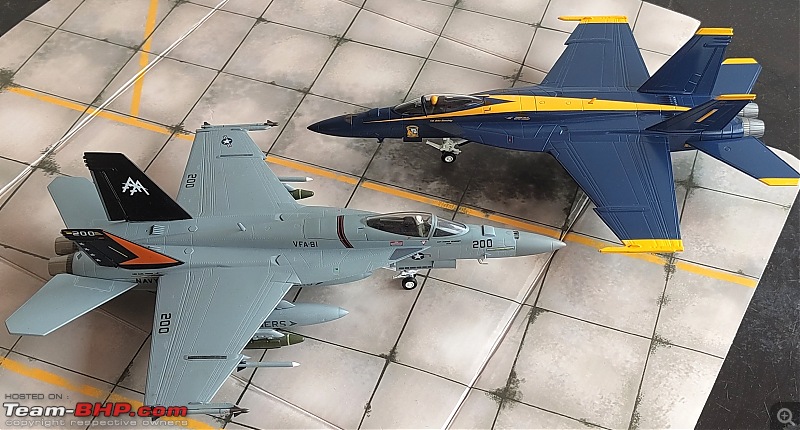 Last edited by skanchan95 : 12th May 2023 at 15:26. | |
| |  (3)
Thanks (3)
Thanks
 |
| The following 3 BHPians Thank skanchan95 for this useful post: | badboyscad, Foxbat, V.Narayan |
| |
| | #2022 |
| Senior - BHPian | Re: Scale Models - Aircraft, Battle Tanks & Ships |
| |  (3)
Thanks (3)
Thanks
 |
| The following 3 BHPians Thank skanchan95 for this useful post: | badboyscad, Foxbat, V.Narayan |
| | #2023 | |
| BHPian Join Date: May 2009 Location: NYC / Lucknow
Posts: 617
Thanked: 3,534 Times
| Re: Scale Models - Aircraft, Battle Tanks & Ships Quote:
I saw this very sad looking F/A-18A in a small museum in California a few years ago. It has the blue angels blue colour but for some reason it says NASA and USAF NAVY on it! The guide was an ex-RF-4C pilot from the Vietnam war and was annoyed with it. 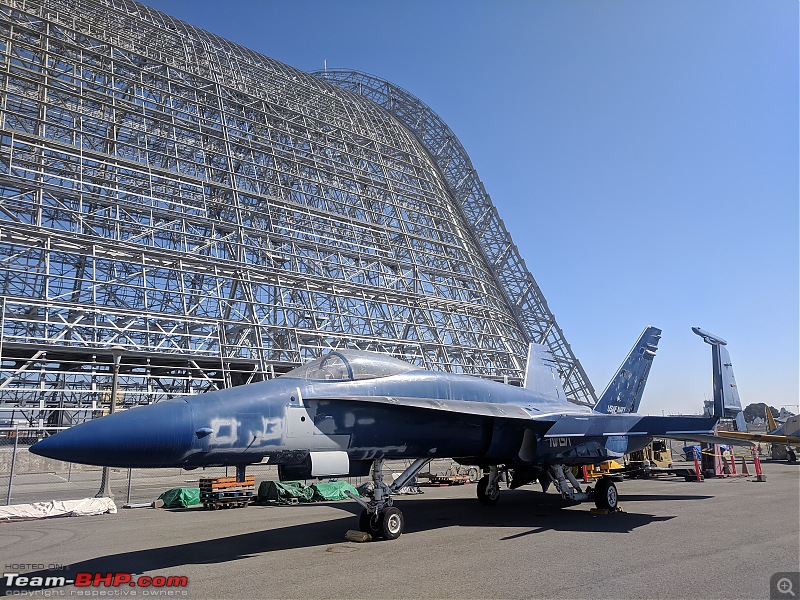 | |
| |  (2)
Thanks (2)
Thanks
 |
| The following 2 BHPians Thank Foxbat for this useful post: | skanchan95, V.Narayan |
| | #2024 |
| BHPian Join Date: Mar 2016 Location: Palakkad
Posts: 608
Thanked: 1,382 Times
| Re: Scale Models - Aircraft, Battle Tanks & Ships I have been a silent admirer of this thread and love the effort put in for these collections. I post rarely. But i got reminded of this thread yesterday when i saw an ad by Amalgam collections with the 1:40 SR 71. I was not able to save the images from the website. So thought of sharing the link in here for others to admire the beauty. https://www.amalgamcollection.com/pr...r-71-blackbird |
| |  (2)
Thanks (2)
Thanks
 |
| The following 2 BHPians Thank rohitoasis for this useful post: | Jeroen, V.Narayan |
| | #2025 | |
| BHPian Join Date: May 2009 Location: NYC / Lucknow
Posts: 617
Thanked: 3,534 Times
| Re: Scale Models - Aircraft, Battle Tanks & Ships Quote:
 I don't understand why its so expensive as the scale 1:40 is not so huge. I don't understand why its so expensive as the scale 1:40 is not so huge. A well detailed kit 1:48 kits cost about $100 and you could pay a professional to built it. Last edited by Foxbat : 13th May 2023 at 21:36. | |
| |  (2)
Thanks (2)
Thanks
 |
| The following 2 BHPians Thank Foxbat for this useful post: | skanchan95, V.Narayan |
 |



